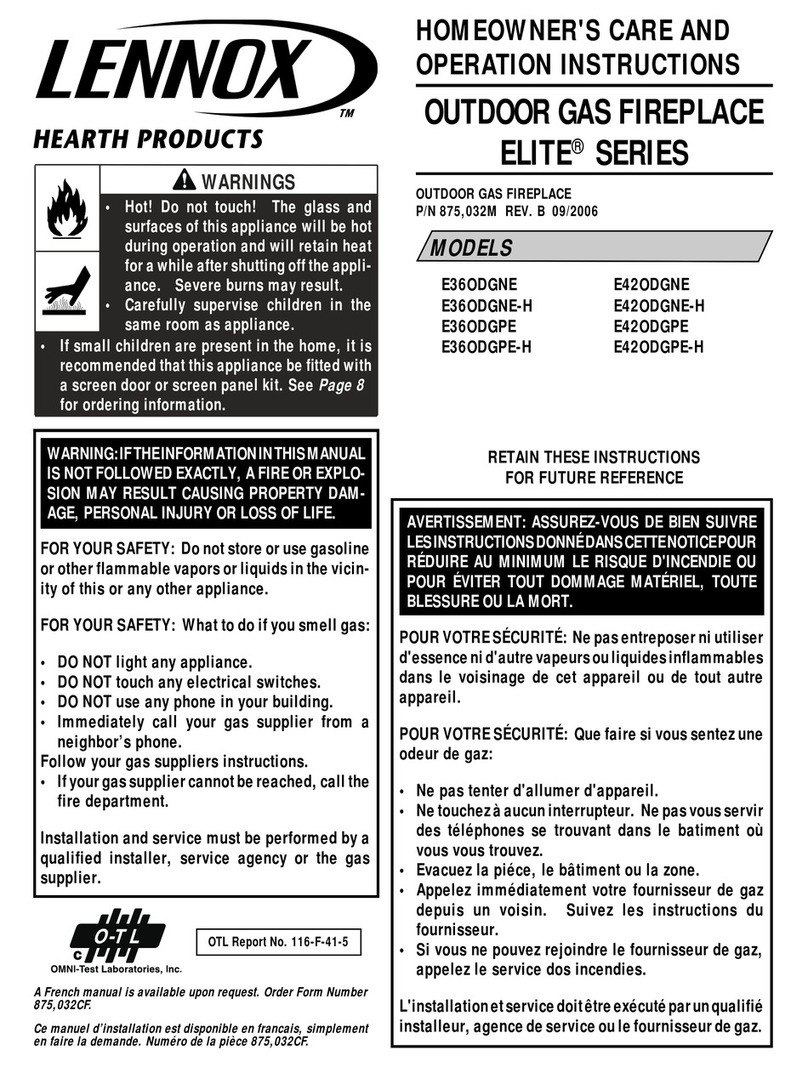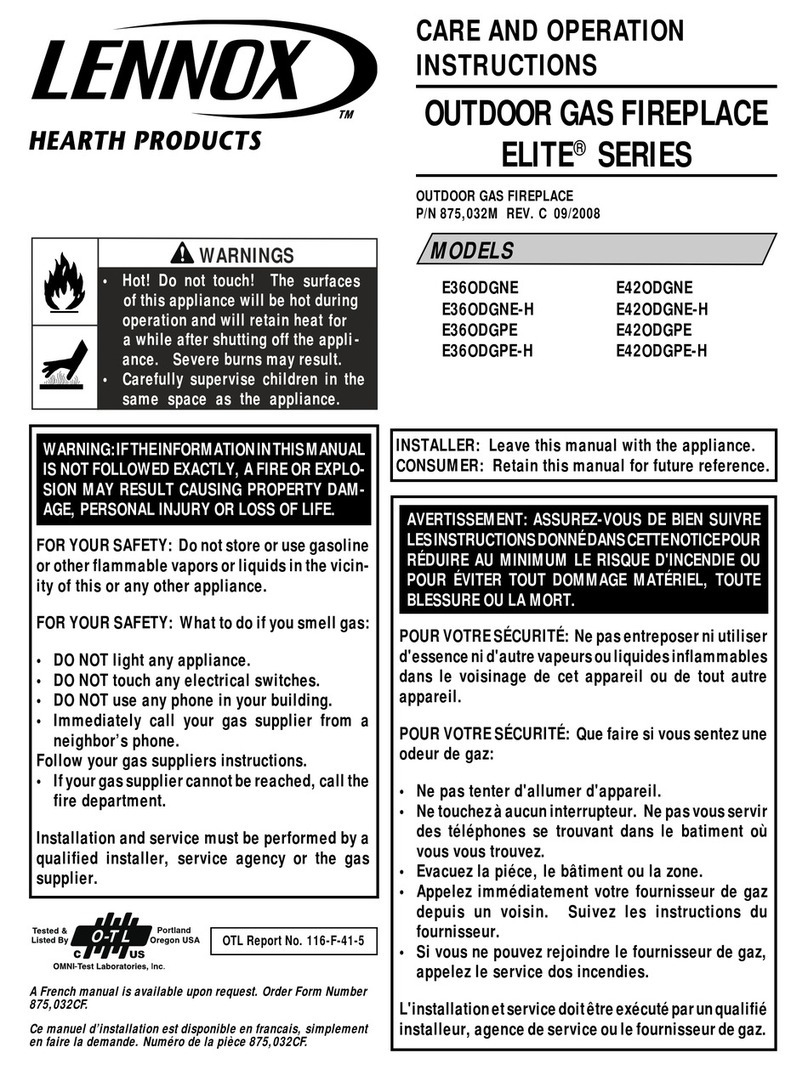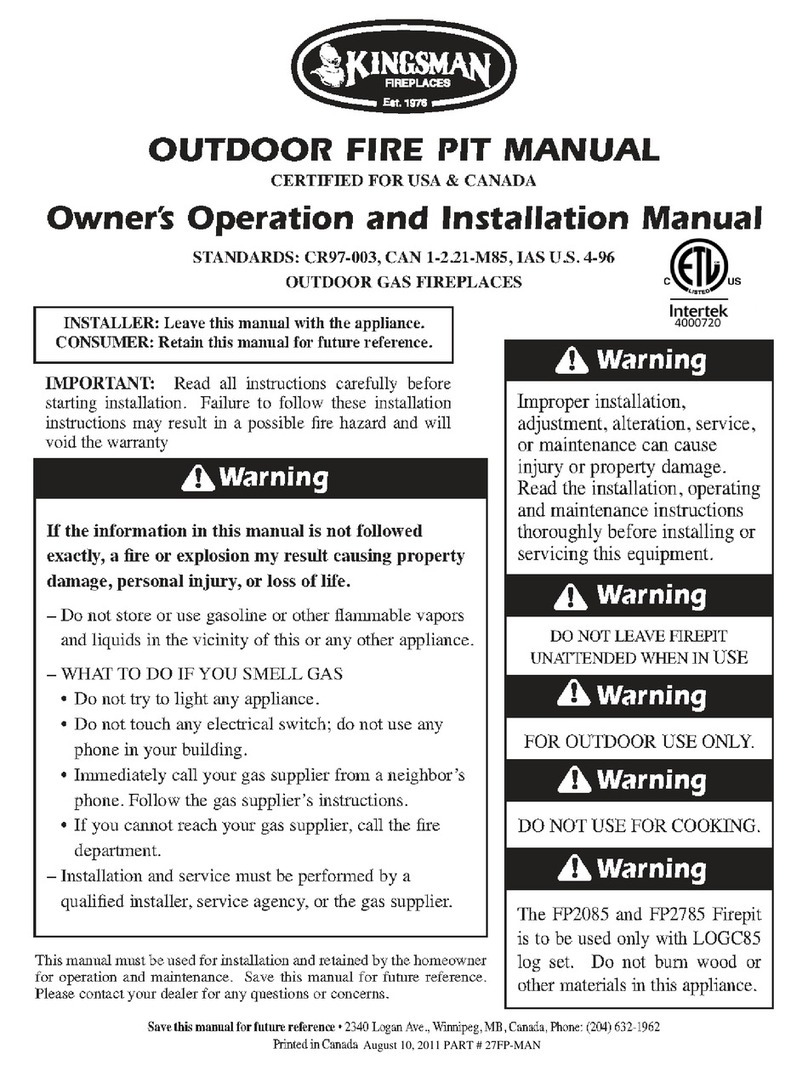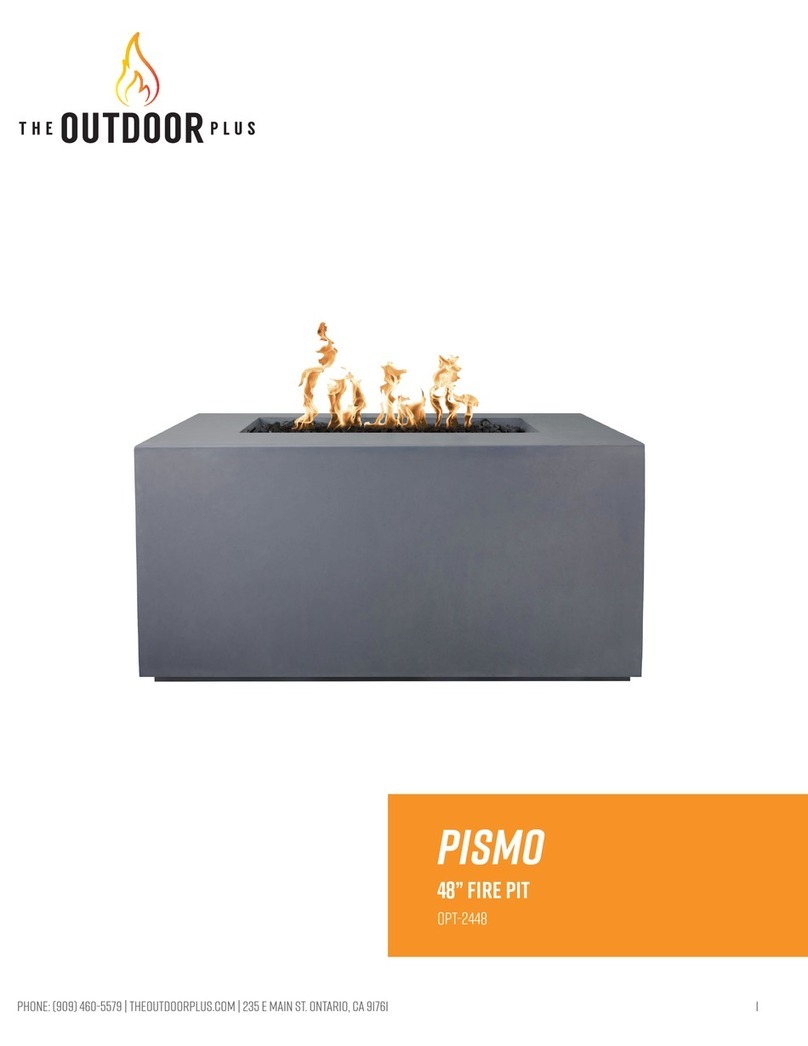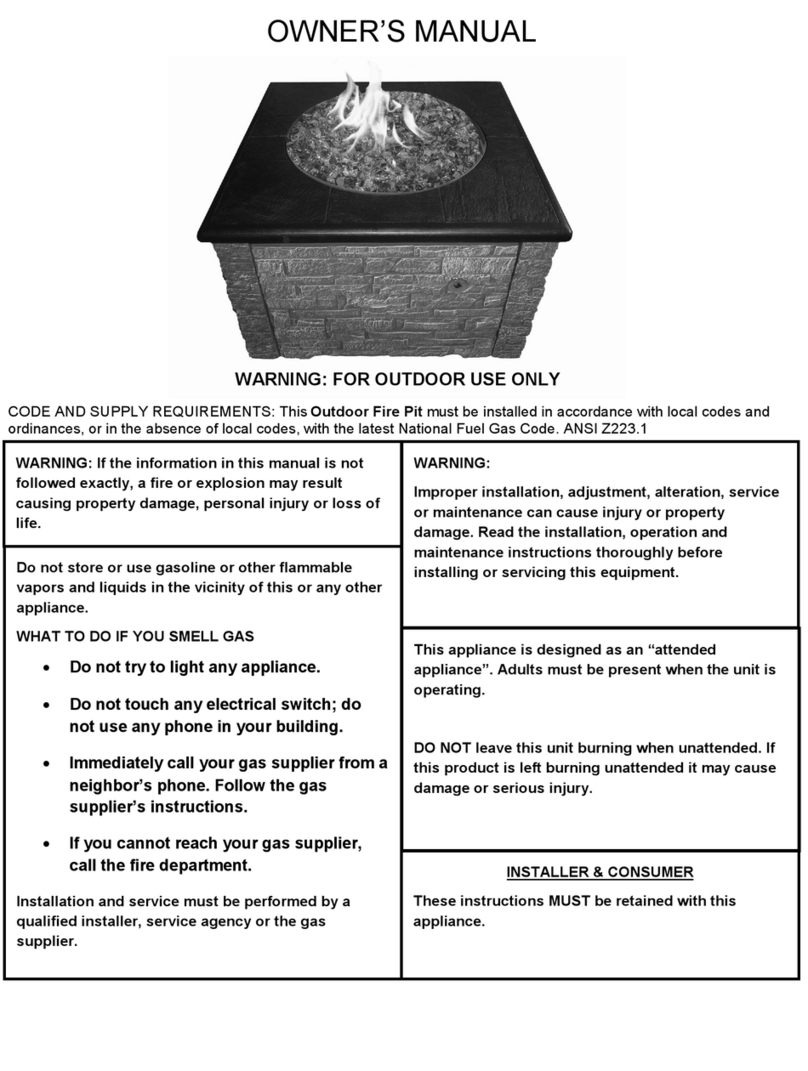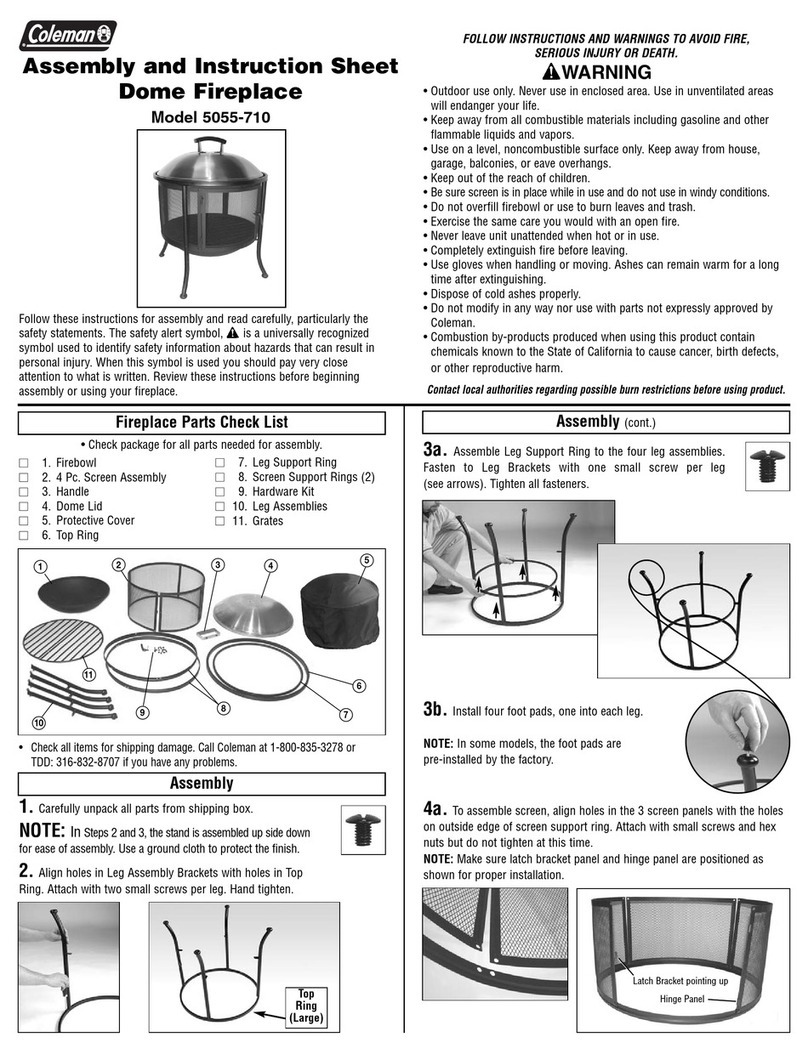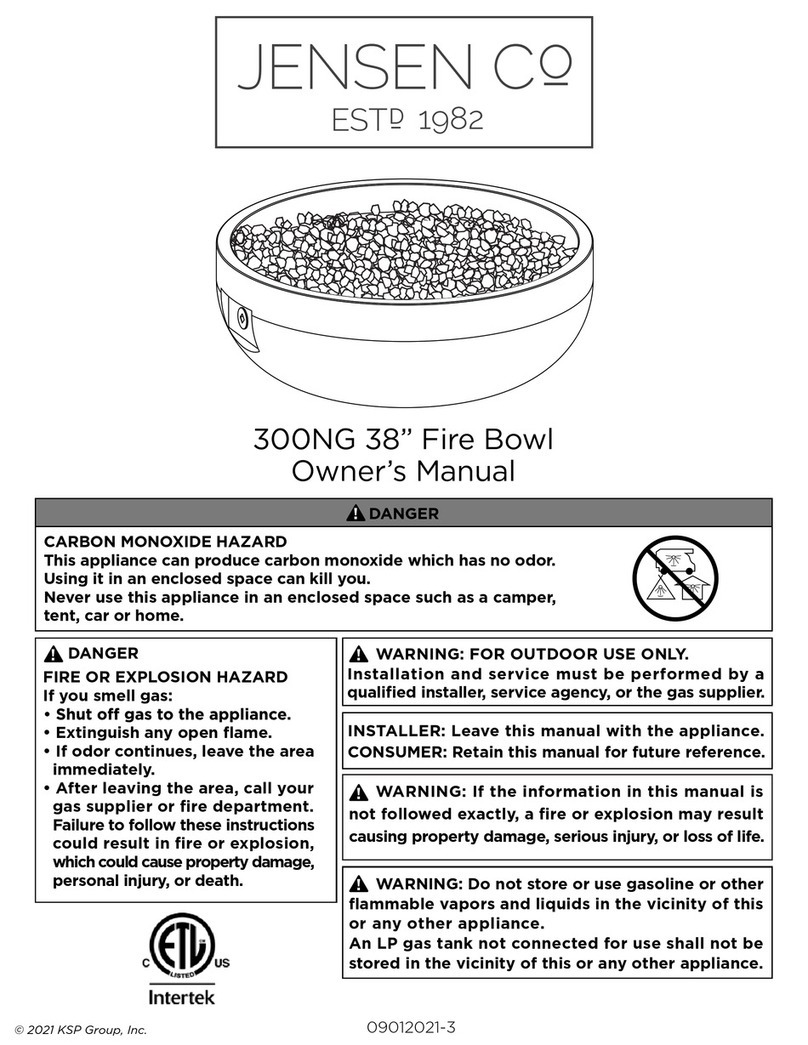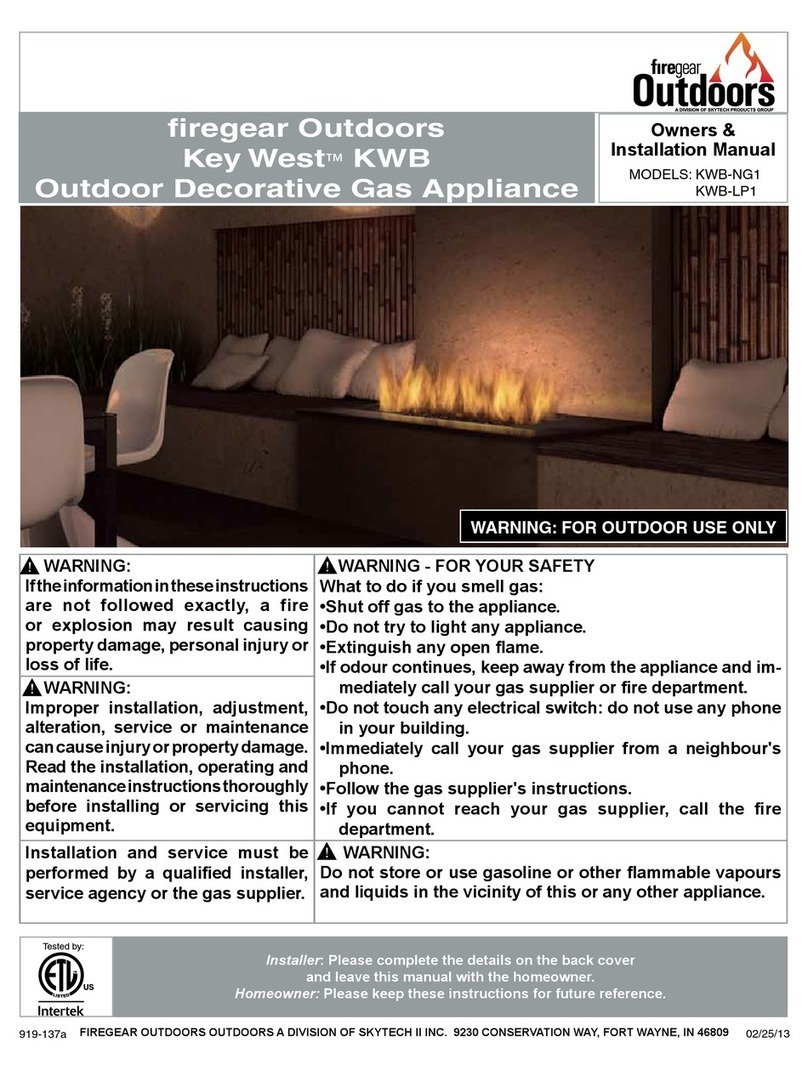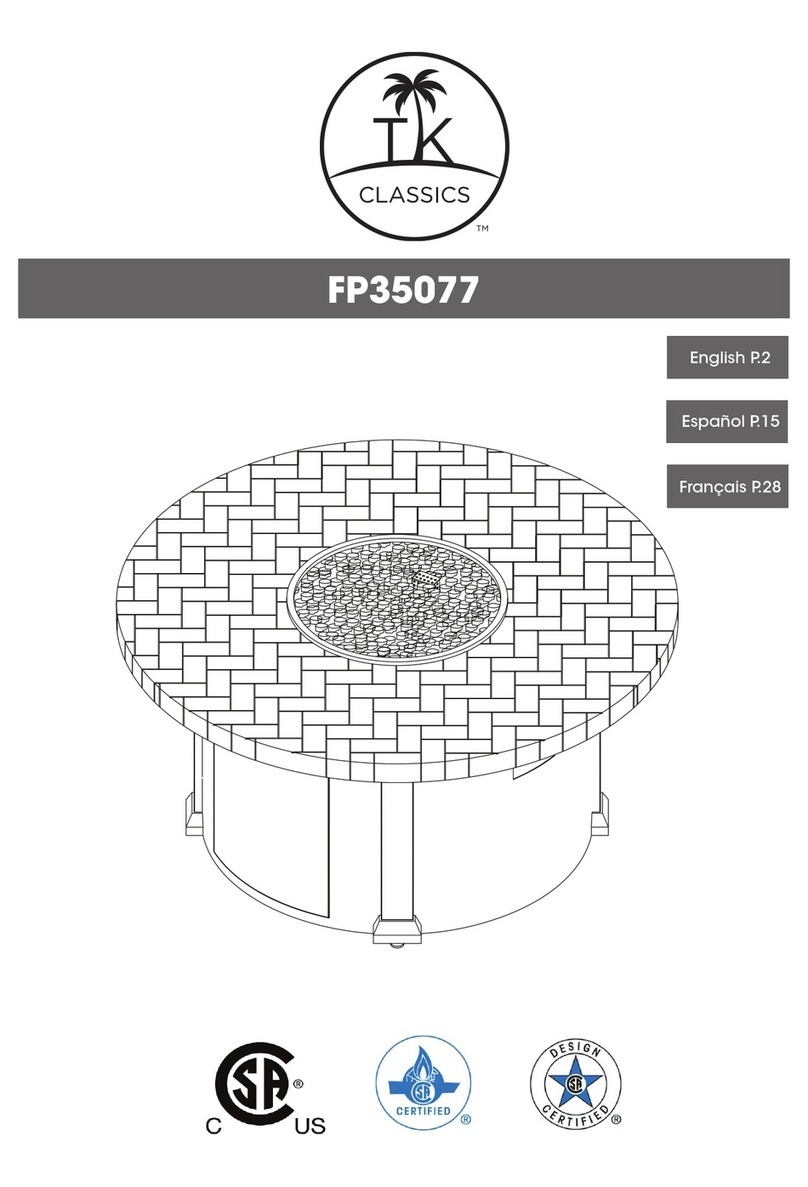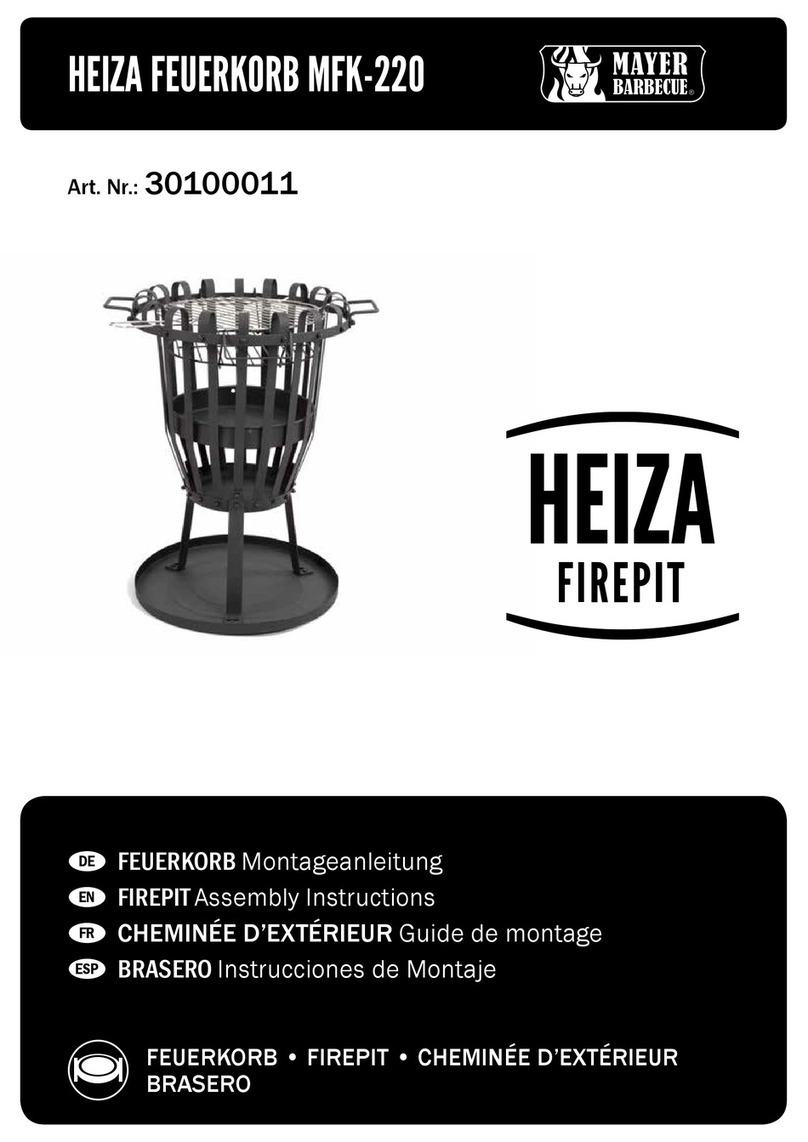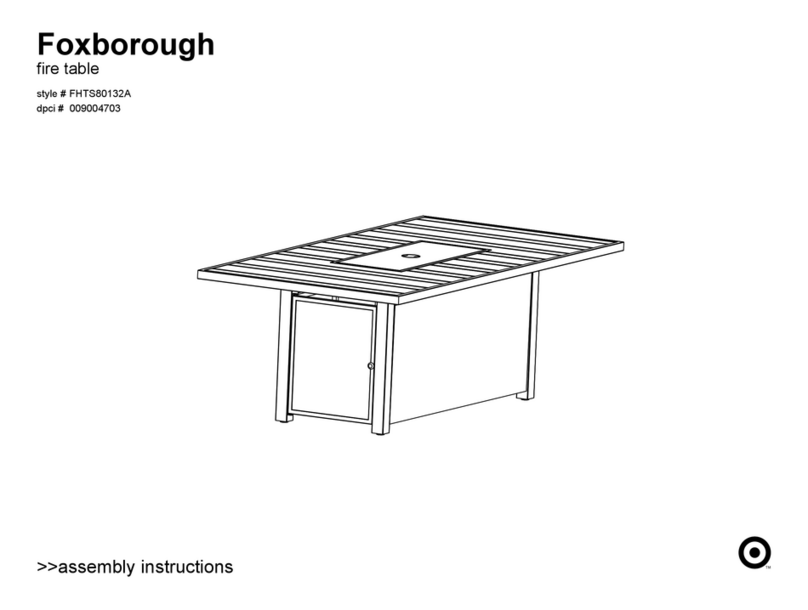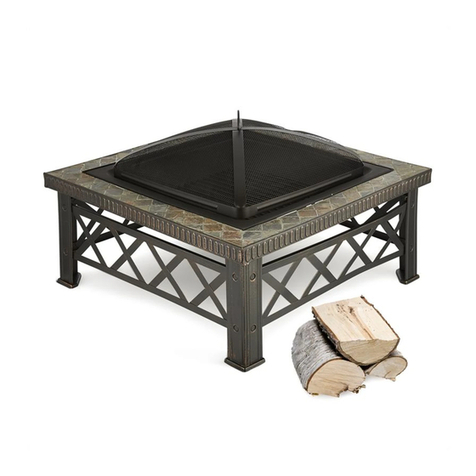Lennox Hearth Products LSO-43 User manual

NOTE: DIAGRAMS & ILLUSTRATIONS NOT TO SCALE. 1
43" Wood Burning Outdoor Fireplace
P/N 850,015M REV. C 03/2007
LSO-43 LSO-43-H
MODELS
RETAIN THESE INSTRUCTIONS
FOR FUTURE REFERENCE
OASIS SERIES
This installation manual will enable you to obtain a safe, efficient and
dependableinstallationofyourfireplacesystem.Pleasereadandunder-
stand these instructions before beginning your installation.
Do not alter or modify the fireplace or its components under any
circumstances. Any modification or alteration of the fireplace system,
including but not limited to the fireplace, chimney components and
accessories,mayvoidthewarranty,listingsandapprovalsofthissystem
and could result in an unsafe and potentially dangerous installation.
IMPORTANT! TO ASSURE PROPER ALIGNMENT OF GLASS DOORS:
INSTALL THIS FIREPLACE IN A SQUARE AND PLUMB CONDITION,
USING SHIMS AS NECESSARY AT SIDES AND/OR BOTTOM.
Note: This fireplace has only been listed and approved for use out of
doors. Significant cold air infiltration will result if installed indoors.
INSTALLATION
INSTRUCTIONS
OTL Report No. 116-F-01-2

NOTE: DIAGRAMS & ILLUSTRATIONS NOT TO SCALE.
2
TABLE OF CONTENTS
Safety Rules .................................... page 2
Tools and Building Supplies ............ page 2
Precautions ..................................... page 2
Introduction..................................... page 3
Clearances/Height Requirements..... page 3
Chimney System ............................. page 4
Assembly Outline............................. page 4
Location of Fireplace ....................... page 4
Assembly Steps............................... page 4
Preinstallation Notes........................ page 4
Waterproofing Fireplace .................. page 5
Outside Air Kit ................................. page 5
Clearances ....................................... page 5
Installing the Fireplace..................... page 5
Fireplace Specifications .................. page 6
Framing Specifications.................... page 7
Installing the Chimney System ........ page 8
30°Offset through Floor/Ceiling...... page 9
Ten Foot Rule Summary .................. page 11
Multiple Terminations...................... page 11
Chimney Component Calculations ... page 11
Special Offset Instructions............... page 12
Offset Calculations........................... page 12
Vertical Elevation Chart................... page 13
Offset Elevation Chart ..................... page 14
Installing Offsets.............................. page 14
Optional Equipment Considerations. page 15
Gas Line Connection........................ page 15
Glass Doors..................................... page 15
Fireplace Finishes ............................ page 15
Mantels and Trim............................. page 16
Hearth Extensions/Wall Shields ....... page 16
Finish Requirements........................ page 18
Installation Components.................. page 18
IMPORTANT: PLEASE READ AND
UNDERSTAND THESE RULES TO
FOLLOW FOR SAFETY.
1. Before starting your fireplace installation,
read these installation instructions carefully to
besureyouunderstandthemcompletelyandin
entirety. Failure to follow them could cause a
fireplacemalfunctionresultinginseriousinjury
and/or property damage.
14. Never, under any circumstances, install a
fireplace, chimney component or any acces-
sories, that has visible or suspected physical
damage as a result of handling or transporta-
tion.Theseitemsshouldbeinspectedbyyour
distributor or qualified factory representative
toensuresafe condition. Whenindoubt, con-
sult your distributor.
15. For additional safety considerations and
complete operating instructions, refer to the
Care and Operation Manual provided with the
fireplace.
TOOLS AND BUILDING SUPPLIES
NORMALLY REQUIRED
Tools should Include:
Phillips screwdriver
Hammer
Saw and/or sabersaw
Level
Measuring tape
Plumb line
Electric drill and bits
Pliers
Square
Building supplies:
Framing materials
Wall finishing materials
Caulking materials (noncombustible)
Fireplace surround and hearth
extension materials (noncombustible)
PRECAUTIONS
Note:Thesefireplacesystemsarenotdifficult
to install. However, in the interest of safety, it
is recommended that the installer be a quali-
fiedorcertified“tradesman”familiarwithcom-
monlyacceptedfireplaceinstallationandsafety
techniques as well as prevailing local codes.
The most important areas of concern dealing
with the installation of factory-built fireplaces
areclearancestocombustiblematerials,proper
assembly of component parts, height of the
chimney system, the proper use of accesso-
ries supplied by the manufacturer and the
techniquesemployedin using finishingmate-
rials applied to the wall surrounding the fire-
place, hearth extensions and wall shields.
Each of these topics will be covered in thor-
ough detail throughout this manual. Please
giveeachyourspecialattentionasyouprogress
with your installation.
2.Alwayscheckyourlocalbuildingcodes.The
installationmustcomplywithalllocal,regional,
state and national codes and regulations.
3.ThisfireplacemustbeinstalledwithSecurity
Chimneys FTF10 [10" (254mm) inside diam-
eter] Chimney System only. This fireplace is
intendedforoutdoorinstallationonly.Thechim-
ney system must always vent to the outside of
the building or structure.
4. To ensure a safe fireplace system and to
preventthebuild-upofsootandcreosote,inspect
and clean the fireplace and chimney prior to use
and periodically during the heating season.
5. Use solid fuel only. DO NOT use artificial
waxbasedlogs,chemicalchimneycleanersor
flame colorants in your fireplace.
6. DO NOT use charcoal or coal under any
circumstances.
7. NEVER use gasoline, gasoline-type lantern
fuel,kerosene,charcoallighterfluid,orsimilar
liquids to start or “freshen up” a fire in this
fireplace. Keep any flammable liquids at safe
distance from the fireplace.
8. NEVER leave children unattended when
there is a fire burning in the fireplace.
9.Beforeservicing,allowthefireplacetocool.
Always shut off any gas to the fireplace while
workingon it. Thiswillprevent thepossibility
of burns.
10.Thisfireplaceisnotaheater.Itisdesigned
to ensure homeowner comfort by providing
supplemental heat to its immediate area.
11. Always ensure that the air inlet to the fire-
placeisfree fromdebrisand any otherobstruc-
tions that can block the entrance of air.
12.DO NOTuseafireplaceinsert oranyother
productsnotspecifiedhereinbythemanufac-
turer for use with this fireplace.
13. "Smoke free” operation is not warranteed
norareweresponsiblefor inadequate system
draft, general construction conditions, inad-
equate chimney heights, adverse wind condi-
tionsand/orunusualenvironmentalfactorsor
conditions beyond our control.
WARNING: TO AVOID THE RISK OF
DAMAGING FIREPLACE MATERIALS
AND INCREASING THE RISK OF FIRE,
DO NOT USE THE FIREPLACE TO COOK
OR WARM FOOD.

NOTE: DIAGRAMS & ILLUSTRATIONS NOT TO SCALE. 3
Figure 1
TYPICAL FREE STANDING INSTALLATION
(MUST BE A MINIMUM OF 10' AWAY FROM ANY BUILDING OR COMBUSTIBLE STRUCTURE)
Whencomplete,thesefireplacesystemscon-
sists of four basic “sub-systems”:
1. The Fireplace
2. The Chimney and Termination
3. Optional Glass Doors
4. Air Inlet
CLEARANCES AND HEIGHT
REQUIREMENTS
Thefireplacemaybeplacedonornearnormal
constructionmaterials*. Theairinlet, firestop
spacerandroofflashing(notchaseflashings)
may be placed directly on or against normal
constructionmaterials.*Thechimneyrequires
a minimum 2" air space to combustibles and
the fireplace outer wrapper requires a mini-
mum 1/2" air space to combustibles. A com-
bustiblemantlemaybeinstalled12"abovethe
opening of the fireplace as per NFPA 211,
Section 7-2.3.3. In Canada, the minimum is
18" (441mm) above the fireplace opening.
Theminimuminstalledheightofthecompleted
fireplacesystem is7'8". The maximumheight
is 80' 0" .
The fireplace and chimney system must be
enclosed when installed in or passing through
alivingareawherecombustiblesorpeoplemay
come in contact with it. This is important to
preventpossible personalinjuryor firehazard.
For questions, please call your distributor or
the manufacturer. Special restrictions apply to
thefrontand facingofthe fireplace andnearby
walls (See pages 16 and 17 ).
INTRODUCTION
General Information
The LSO-43 fireplace is a traditional wood
burning radiant heat system. The LSO-43-H
comes with Herringbone styled refractory.
Thesefireplacescomewithstandardbargrates,
air inlet and optional decorative glass doors.
Thefireplace isintended tobe installedoutside
of the home. It could be installed against the
outside wall of the house, or as a freestanding
fireplace on the porch, patio, or simply located
in the yard (
see Figure 2
).
The Outdoor Fireplace must be enclosed. To
prevent impact damage to the outside of the
fireplace. Build an outside enclosure out of
standard building materials, being careful to
maintaintheminimum air clearancesspecified
in these Installation Instructions.
Wheninstallingthefireplaceasafreestanding
unit on your porch, patio or backyard, it must
alsobeenclosedto prevent impact damage to
the fireplace. However, the enclosure must
now be finished on all four (4) sides. The
exterior of the enclosure may be finished in a
textured plywood, a wood clapboard siding,
brick, or a cultured stone. Vinyl siding is not
recommended for use on the front of the
fireplace due to the heat the unit produces.
This can cause the vinyl siding to deteriorate.
These fireplace systems are designed for in-
stallation in accordance with the National Fire
Protection Standard for chimneys, fireplaces
and solid fuel burning appliances; NFPA 211
and in accordance with codes such as the
BOCABasic/NationalCodes,theStandardMe-
chanicalCodeandtheUniformBuildingCodes.
Note:Illustrationsshownreflect“typical”instal-
lations with nominal dimensions and are for
designandframingreferenceonly.Actualinstal-
lationsmayvaryduetoindividualdesignprefer-
ences.However,alwaysmaintainminimumclear-
ances to combustible materials and do not vio-
late any specific installation requirements.
Thesefireplaceshavebeentestedandlistedby
OmniLaboratories(ReportNo.116-F-01-2)to
U.L. standard 127 for US and ULC S610 for
Canada. These units are intended for installa-
tion outside of a residential building only.
*Construction Materials:
• framing materials • paneling
• particle board • flooring
• dry wall • etc.
• plywood
Chimney Section
(FTF10-36)
LSO-43 Shown
Air Inlet
(Provided)
Flashing
(Locally
Fabricated)
Storm Collar
(FSC)
Termination
(FTF10-CTDT)
Use Only
Non-Combustible
Materials From
Top Of Spacers Down
Metal Safety Strips
And Hearth Extension
Required When Installed
On Combustible Floor
Or In Proximity To
Combustible
Floor/Covering
7’ 8” Minimum
(7’ 10” Minimum
With FTF10-CT1)
NOTE: Framing is shown as reference only. It can differ according to design and local building codes.
WARNING: FAILURE TO USE MANUFAC-
TUREPROVIDEDPARTS,VARIATIONSIN
TECHNIQUES AND CONSTRUCTION MA-
TERIALS OR PRACTICES OTHER THAN
THOSE DESCRIBED IN THIS MANUAL
MAY CREATE A FIRE HAZARD AND VOID
THE LIMITED WARRANTY.
WARNING: DO NOT PACK OR FILL RE-
QUIRED AIR SPACES WITH INSULATION
OROTHER MATERIAL. NO MATERIAL IS
ALLOWED IN THESE AREAS.
WARNING: IF INSULATION IS USED,
THE FIREPLACE MUST NOT BE PLACED
DIRECTLY AGAINST IT. INSULATION
OR VAPOR BARRIERS, IF USED, MUST
FIRST BE COVERED WITH GYPSUM
BOARD, PLYWOOD, PARTICLE BOARD
OR OTHER MATERIAL TO ASSURE IN-
SULATION AND VAPOR BARRIERS RE-
MAIN IN PLACE.

NOTE: DIAGRAMS & ILLUSTRATIONS NOT TO SCALE.
4
Figure 3
Figure 2
When choosing a location, care must be taken
toavoidplaceswherefloodingorrunningwater
may be a problem.
Carefully consider the position of the fireplace
openingwithrespecttothelocationofadjacent
or nearby stairwells, doors, windows, walk-
waysandoverhangingtrees,patiosandwires.
Whenlocatingthefireplace,considerationmust
be given to combustibles and final finishing.
See
Figure 3
and confine the final location of
combustiblefinishmaterialstothe"SafeZone".
DO NOT place furniture or other items such
as plants or decorative objects within 60" of
the fireplace front face.
Wall
Covering
Frame Surface Not
To Be Covered With
Combustible Materials
Safe
Zone
45°
18”
Door
Opening
1”
18”
LIVING SPACE
PATIO
Optional
Hearth
Extension
Air Inlet
(Inlet Must
Be Free Of Any
Obsutuctions)
CHIMNEY SYSTEM
These fireplaces are designed and code listed
forusewithSecurity's FTF10 chimney System
only. Always use Security's FTF10 chimney
componentswiththesefireplaces.Donotmodify
or alter these components as this may cause a
potentialserioushazardandvoidtheWarranty.
Note: Do not insulate the chase cavity with
blown or fill type insulation materials.
Note: Localcodes may not require firestopsat
the ceiling levels for outside chase installa-
tions. However, it is recommended for safety
and the reduction of heat loss.
Chimney Height
The total height of your completed fireplace
system from the surface the fireplace rests
on to the chimney top must not exceed 80'
(24.4) and must also meet minimum height
requirements.Refertotheminimumsystem
height chart.
ASSEMBLY STEPS
Note:Thefollowingstepsrepresentthenormal
sequence of installation. Each installation is
unique,however, and might require a different
sequence.
1. Position firebox prior to framing or into
prepared framing.
2.Waterproofthefireplace(
seeWaterproofing
The Fireplace on page 5
).
3. Install the chimney system.
4. Install air inlet.
5. Plumb gas line if a decorative gas appliance
will be used. (Gas connections should only be
performed by an experienced, licensed/certi-
fied tradesman.)
6. Complete the installation, finish wall mate-
rial, surround and hearth extension to your
individual taste.
7. Assemble and attach optional glass door
assembly.
Study the three dimensional illustration (
Fig-
ure1
) togeta generalidea ofeachelement of
your fireplace system.
PRE-INSTALLATION NOTES
The fireplace may be installed directly on a
combustiblefloororraisedonaplatformofan
appropriate height. Do not place the fireplace
on vinyl or other soft floor coverings. It may,
however, be placed on flat wood, plywood,
particle board or other hard surfaces.
Be sure the fireplace rests on a solid continu-
ousfloororplatformwithappropriateframing
for support.
The fireplace may be positioned and then the
framingbuiltaroundit,orthe framing may be
constructed and the fireplace positioned into
the opening.
Usually,nospecialfloorsupportisneededfor
the fireplace, however, to be certain:
1. Estimate the total weight of the fireplace
system including chimney and surround ma-
terials such as brick, stone, etc., to be in-
stalled. Shippingweightsforthefireplacemay
be found on page 18.
2. Measure the square footage of the floor
spacetobeoccupiedbythesystem,surrounds
and hearth extensions.
LOCATION OF FIREPLACE
Carefullyselecttheproperlocationforchimney
obstructions, clearance to side wall(s) air inlet
location and aesthetics. With proper pre-plan-
ning, a slight adjustment of a few inches can
save considerable time and expense later dur-
ing construction and assembly. See
Figure 2
for some examples.
*Whenthefireplaceisinstalledanywherecloser
than 10 feet from any building or structure.
Minimum Height
Theminimum heightfora completesystemis
10'6"ifinstalledwithanFTF10-CT1orFTF10-
CTDT terminations. Any other termination
requires a 14' minimum system height.
Free Standing Installation
Thesystemheight may be reduced to a single
length of FCTF10-36 pipe and termination
(minimum7'8") with eithertheFTF10-CTDor
FTF10-CT1. Thefireplacemustbeinstalledas
afreestandingsystemandlocatedaminimum
of 10' away from any building or structure
(
refer to Figure 1
).
ASSEMBLY OUTLINE
Before You Start
Checkyourinventorylisttobesureyouhaveall
the necessary parts supplied in good usable
condition.Checkalsoforanyconcealeddamage.
MINIMUM SYSTEM HEIGHT
Security's FTF10 Pipe
Vertical 10' 6"*
Installation ( 3.2 m)
One 14'
Offset ( 4.3 m)
Two 22'
Offsets ( 6.7 m)

NOTE: DIAGRAMS & ILLUSTRATIONS NOT TO SCALE. 5
Figure 6
Figure 5
INSTALLING THE FIREPLACE
Step1. Slidethe fireplaceinto preparedfram-
ingorpositionfireplaceinitsfinalpositionand
frame later.
Thefireplace maynot berecessed intoacom-
bustible floor. Maintain the floor to hearth
clearance established by the fireplace lower
front face.
Step 2. Inserttheprovided metalsafetystrips,
beneaththefireplaceasillustrated(
Figures5,6
and 7
). The safety strips should overlap ¹⁄₂"
min. for continual coverage of the floor.
Air Inlet
Theinstallationof the airinlet is requiredfor
safe fireplace operation.
Step 1. Determine the location for air inlet,
which can be installed through an outside
wall. A 6 1/2" diameter hole will be required
for installation of the air inlet assembly (
see
Figure 17
).
CAUTION: AVOID INSTALLING THE AIR IN-
LET WHERE THE OPENING COULD BE
BLOCKED BY SNOW, BUSHES OR OTHER
OBSTACLES. THE MAXIMUM HEIGHT FOR
THE OUTSIDE AIR IS 50 FEET ABOVE THE
HEARTH,PROVIDINGTHEAIRINLETISTER-
MINATED A MINIMUM OF THREE (3) FEET
BELOW THE CHIMNEY CAP LEVEL.
Note: Air inlet ducts must not terminate in
attic space.
CLEARANCES
Minimum clearance to combustibles for the
fireplace is as follows; sides and back – ¹⁄₂"
(13mm), combustible floor – 0" (0mm), adja-
centwall18"(457mm),adjacentshieldedwall
(
K factor of .84 or less 40" W x 40" H
) 12"
(305mm), ceiling – 37 ¹⁄₂" (953mm).
Refer to
page 17 for more detail
.
Figure 4
Metal Safety Strip Floor
Hearth
Extension
¹⁄₂" (13mm)
Maintain
¹⁄₂" (13mm)
Air Space
at Sides
and Back
Combustible
Wall
Fireplace On Non-Combustible Floor
Metal Safety Strip Floor
¹⁄₂" (13mm)
Maintain
¹⁄₂" (13mm)
Air Space
at Sides
and Back
Combustible
Wall
Platform
Hearth
Extension
Fireplace On Combustible Floor
Drain Connector
(see Detail A )
Seal All
Seams,
Joints
And
Corners
Around The
Bottom Of
Fireplace
Access
Drain Plug
Through
Air Inlet
Opening
Detail A
Threaded
Reducer
³⁄₄” x ¹⁄₂”
(PVC)
Threaded
Elbow ³⁄₄”
@ 90°
(PVC)
Step 2. Locatethe drainageplugandremove
it by depressing the locking tabs and pushing
down through the outside air opening at the
bottom of the fireplace.
Step 3. On the exposed hole, install a PVC
threaded coupling reducer, 3/4" x 1/2" going
from inside of the fireplace out. Apply a
silicone-based sealant around the base and
threads before installation.
Step 4. Holding the reducer coupling with a
wrench,threada3/4",90degree,PVCelbowto
the reducer until it is tight to the metal.
Note: Toassureproper drainage, the fireplace
must be installed on a leveled surface.
Note: Clearance at the nailing flange for both
fireplace models is 0" (0mm).
Note: Adjacent wall considerations are for an
adjacent wall on only a single side. Walls
should not be placed at minimum distance at
both sides of the fireplace.
Note: The LSO-43 has been provided with a
drain plug under the fireplace by the air inlet
opening. If the fireplace is on a platform or
woodensurface,ahole mustbeboredtomake
roomforanelbowconnector. Ifthefireplaceis
on a concrete floor, it will be necessary to
elevate the appliance at least 1" high to permit
the installation of an elbow connector.
Step1. Sealalljoints,gapsandcornersaround
the bottom of the fireplace before positioning
the fireplace on its location (
Figure 4
).
3.Notethefloorconstruction,i.e.2x6’s,2x8’s
or 2 x 10’s, single or double joists, type and
thickness of floor boards.
4. Use this information and consult your local
building code to determine if you need addi-
tional support.
If you plan to raise the fireplace and hearth
extension, build the platform assembly then
positionfireplaceandhearth extension on top.
Secure the platform to the floor to prevent
possible shifting.
WATERPROOFING THE FIREPLACE
AlthoughtheLSO-43fireplaceisdesignedto
drain to the front most of the water from rain
and other sources that may enter the hearth
area, condensation and unusual conditions
may cause water to collect inside the fire-
place bottom.
To prevent this, the builder must provide a
means to drain water from under the fire-
placebybuildingorinstallingawatercollec-
torofthebuilder'schoice,orinstallingaPVC
drain as follows:

NOTE: DIAGRAMS & ILLUSTRATIONS NOT TO SCALE.
6
FIREPLACE SPECIFICATIONS
Figure 9
Step 3. Refer to fireplace drawings and speci-
fications on pages 6 and 7 for framing dimen-
sionsanddetails.Frameapplianceenclosureas
illustrated in
Figures 10 through 13
on page 7.
IMPORTANT: UNDER NO CIRCUMSTANCES
CANTHEFIREPLACETOPSPACERS(
FIGURE
9
) BE REMOVED OR MODIFIED, NOR MAY
YOU NOTCH THE HEADER TO FIT AROUND
OR BE INSTALLED LOWER THAN THE SPAC-
ERS. THE HEADER MAY BE IN DIRECT CON-
TACTWITHTHETOPSPACERSBUTMAYNOT
BE SUPPORTED BY THEM.
Figure 8
Figure 7
11"
(279mm)
49 ⁵⁄₈"
(1260mm)
31" (788mm)
9 ³⁄₄"
(248mm)
¹⁄₂" (13mm)
Front View
51 ¹⁄₈"
(1299mm)
6 ¹⁵⁄₁₆"
(176mm)
1 ⁹⁄₁₆"
(40mm)
¹⁄₂"
(13mm)
42 ³⁄₄" (1086mm)
24 ¹⁄₁₆"
(611mm)
4 ³⁄₁₆"
(106mm)
¹⁄₂"
(13mm)
25 ¹⁄₈"
(638mm)
5 ¹⁄₁₆"
(129mm)
11 ⁵⁄₁₆"
(287mm)
8 ⁵⁄₈"
(219mm)
52 ¹⁄₄" (1327mm)
39 ¹¹⁄₁₆"
(1008mm)
4 ¹⁄₂"
114mm)
Side View (Left)
Top View
44 ⁵⁄₈"
(1133mm)
12 ⁷⁄₁₆"
(316mm)
39 ¹¹⁄₁₆"
(1008mm)
9 ¹⁵⁄₁₆"
(252mm)
1
⁹⁄₁₆
"
(40mm)
1 ¹⁄₄"
(32mm)
Drain
Plug 11 ⁵⁄₁₆"
(287mm)
Metal Safety Strips
with ¹⁄₂" (13mm) Min.
Overlap
1 ¹⁄₂"
(38mm)
The safety strips should extend from front of
thefireplaceat least1¹⁄₂" andshouldextendto
be at least flush with the sides. In the event a
woodensupportisusedtoelevatethefireplace
abovethefloor,a“Z”typesafetystripshouldbe
fabricatedandusedtoprotectthefrontsurface
ofthewoodsupportaswellasthefloorbeneath
the hearth extension (
Figures 7 and 8
). The
safetystrips shouldbetacked downtoprevent
possible movement.
Note: The “Z” type safety strip is not supplied.
Special “Z” Metal Safety
Strips with ¹⁄₂" (13mm) Min.
Overlap
2"
(51mm)
Blocking
Note: Safety strips are not required when fire-
place rests on a noncombustible surface.
Note:Installthehearthextensiononlyasillus-
trated (see Figures 41 and 42 ).

NOTE: DIAGRAMS & ILLUSTRATIONS NOT TO SCALE. 7
Note: The framed depth, 25
⁵⁄₈
" (651 mm)
fromaframedwall,mustalwaysbemeasured
fromafinishedsurface.Ifawallcoveringsuch
as drywall is to be attached to the rear wall,
thentheframeddepthmustbemeasuredfrom
the drywall surface. It is important that this
dimension be exact.
If the appliance is to be elevated above floor
level, a solid continuous platform must be
constructed.
Consult all local codes.
Figure 10
Figure 11
Framing Dimensions for Ceiling
Flue Type A B
FTF10 Vertical 19" 19"
(483 mm) (483 mm)
FTF10 19" 29"
Offset 30°(483 mm) (737 mm)
Figure 12
Framing Dimensions for Roof
Pitch C D*
0/12 19" 19"
(483 mm) (483 mm)
6/12 19" 22"
(483 mm) (559 mm)
12/12 19" 27"
(483 mm) (686 mm)
* Perpendicular to roof ridge
Figure 14
Figure 15
Figure 13
Note: Allframingdimensionscalculatedfor1/2"
dry wall at the fireplace face. If sheathing the
chaseorfinishingwithotherthicknessmaterials,
calculations will need to be made.
FRAMING SPECIFICATIONS
Framing Dimensions
Fireplace Opening Width
LSO-43
A52 ⁷⁄₈" (1343 mm)
B50" (1270 mm)
C31 ³⁄₄" (806 mm)
D15 ⁷⁄₈" (403 mm)
E82" (2083 mm)
F41" (1041 mm)
G25 ⁵⁄₈" (651 mm)
J13 ⁷⁄₈" (352 mm)
K58" (1473 mm)
Header
Fireplace Framing
B
A
A
B
Ceiling Framing
C
D
Roof Framing
A
G
Inside Chase
Back Wall of Chase/Enclosure
Including Finising Materials if any
Rough
Framing Face
(Unfinished
Shown)
Outside
Air Kit
A
E
F
D
C
K
Back Wall of
Chase/Enclosure
Including Finishing
Materials if any
Rough
Framing Face
(Unfinished Shown)
Corner Installation
Outside
Air Kit
Optional
Drainage Line
Outside
Air Kit
G
A
J
Outside Chase
Back Wall of Chase/Enclosure
Including Finishing
Materials if any
Rough Framing Face
(Unfinished Shown)
Optional
Drainage
Line

NOTE: DIAGRAMS & ILLUSTRATIONS NOT TO SCALE.
8
Step 4. The fireplace should be secured to the
sideframingmembersthroughthenailingflange
(
Figure 16
).
Figure 16
Note: The nailing flange and the area directly
behind the nailing flange is exempt from the
clearances described on the fireplace clear-
ance label.
Step 5. Connect the 6" (152 mm) Class 0 air
duct provided, to the collar on the fireplace
withtheclampsprovidedinthekit’shardware
package (
Figure 17
).
Step 2. Position the appropriate firestop
spacerattheceilingandfastentemporarilywith
two(2)8dnailsorequivalent.Useaflatfirestop
spacer,ModelF10FS-2,fortheFTF10systemif
chimney penetrates vertically. If the chimney
penetrates through the ceiling at a 30°angle
(offsetchimney)thenusea30°firestopspacer,
Model F10FS30-2. Use one nail on opposite
sides of the firestop to hold in position. Fasten
permanently, using at least two (2) more 8d
nails or equivalent, after the chimney sections
have been assembled through the firestop
spacer and after necessary adjustments have
been made. The firestop spacer must be se-
cured in place by at least four (4) 8d nails or
equivalent when completely installed.
Note:Ifpatioinstallationrequiresthatachim-
ney passes through a roof or room above, be
sure to comply with all local building codes.
Figure 19
Reference
Figures14and15
andcharts“Fram-
ing Dimensions for Ceiling and Roof,” which
specifyminimumceiling and roofdimensions.
Fornewconstruction,todeterminechimneycen-
terline,useplumblinefromceilingorroofabove
fireplace to the center of fireplace flue collar.
For remodeling, plumb to the center of the
fireplace flue collar from the ceiling or roof
above. Drive a nail through the ceiling or roof
from below to mark position. Mark and cut a
holeintheceiling(aroundthenail)(
Figure19
).
Thenplumbfrom ceiling or roof directlyabove
the cut hole to determine roof hole position.
Step6.RoutetheClass0airductouttheback
or side to an outside wall. The duct inlet
shouldbelocatedaboveanyanticipatedsnow
level. Check local building codes for any
restrictions. We recommend that the inlet
be at least 4 feet above grade level.
Step 7. Cut or frame a hole through the
outsideoftheenclosurefortheinstallationof
the duct inlet hood. A 6 ¹⁄₂" (165 mm) diam-
eterholeisrequired.Feedthelooseendofthe
flexibleduct throughtheholecutfor theinlet
hoodandattachtothecollarontheinlethood
using one of two clalmps provided with the
kit. Insert the hood into the opening. Secure
inplacewithnailsdriventhroughtheholesin
hood flange. Seal with noncombustible wa-
terproof silicon type caulking. If additional
duct is needed, use Class 0 metallic air duct
(
refer to Figure 17
).
INSTALLING THE CHIMNEY SYSTEM
Step 1. Using standard construction framing
techniques, construct openings for the chim-
ney through the ceiling(s) and roof or through
anoutsidechase.Allframingmustmaintainthe
minimum air space clearance at all times.
CAUTION: ALLOW A MINIMUM 2" (51 MM)
CHIMNEYAIRSPACETOCOMBUSTIBLEFRAM-
INGMEMBERSTHROUGHOUTVERTICALAND/
OR OFFSET CHIMNEY INSTALLATIONS.
A minimum 2" (51 mm) air space must be
reserved for all combustible and noncombus-
tible materials extending for any continuous
length surrounding the chimney.
Figure 18
Figure 17
Air Duct
Air Inlet
Clamps
Note: Air Inlet
Must Be Free Of
Any Obstructions
3 Feet
Note: Secure the duct hood to a vertical post
with the inlet positioned downward. Ensure
that nothing blocks the hood opening. This
duct must never terminate higher than 3 feet
below the fireplace termination (Figure 18 ).
8d Nail Or
Equivalent
Framing
Stud
Nailing
Flange

NOTE: DIAGRAMS & ILLUSTRATIONS NOT TO SCALE. 9
Figure 20
Figure 21
Figure 22
Theouterchimneysectioninstallstheopposite
way; the lanced end goes down and each new
section installs OVER the outside of the previ-
ous section (
Figure 23
).
Figure 23
Continue to assemble the chimney up through
framedopening.Assemblejustenoughtopen-
etrate the roof flashing openings (
Figure 24
).
Alwaysmaintain2"minimumairspacetocom-
bustiblematerialsandalwayscheckeachchim-
ney joint (inner and outer) to ensure proper
engagement.Checkverticalalignmentofchim-
ney so that it projects from the roof in true
vertical position.
Figure 24
Security's chimney sections do not need to be
screwed together. Additional reinforcement is
not necessary except in certain offset condi-
tions (refer to page 12,
Figure 35
).
Step 4. The height of vertical chimney pipe
supported only by the fireplace must not ex-
ceed 30'. Chimney heights above 30' must be
supported by a Model FTF10-S4 stabilizer in-
stalled at 30' intervals.
Note:TheModelFTF10-S4adds3"neteffective
height to the total chimney system.
F10FS30-2
Firestop Spacer
FTF10-S4
Stabilizer
2" (51mm)
Min. Air
Space
30°Firestop
and Space Above
10' (3m) Max.
2" (51mm)
Min. Air
Space
F10FS30-2
Firestop Spacer
30°Firestop and
Space Above
10' (3m) Max.
2" (51mm)
Min. Air
Space
2" (51mm)
Min. Air
Space
FTF10-S4
Stabilizer
Locking Tabs
(Lances)
2" (51mm) Min.
Air Space to Combustibles
Step 3.
Note: All chimney sections are con-
structed with a unique locking tabs and hem
design, which ensures and immediate, tight
assemblybetweensections.Planyourchimney
requirementscarefullybeforeassembly,asthe
chimneyisdifficulttodisassembleafterinstal-
lation.Ifdisassembled, thetabsmight become
damaged. Be certain that the tabs are properly
formed to ensure they engage properly.
Note: For Canadian installations, all chimney
installedoutsidethebuildingmustbeconstructed
with galvalume (outer sections only) effective
January 1, 1992. The appropriate model desig-
nations are located in the back of this manual.
Install the Model FTF10-S4 stabilizer by fitting
inner section down into respective section of
proceeding flue pipe and locking outer stabi-
lizer section into place over the outer chimney
pipe. Position for proper clearance through
framedopeningandnailstrapssecurely(under
tension in “shear”) into place on framing. Use
8dnails.Attachsuccessivelengthsofchimney
pipe directly to stabilizer using same tech-
niques as described in Step 3 (
Figure 25
).
Figure 25
FTF8-S4 Stabilizer
Note:Assembleonecomponentofchimneyata
time(innersection first;thenoutersectionlast)
beforeprecedingwiththenextcompletesection.
TheFTF10chimneysystemisatwopiecechim-
ney that snap locks together from the fireplace
up.Alwaysstartwiththeinnerfluesection.With
the lanced end up, snap lock the joint into the
matching collar on top of the fireplace. At all
subsequentjoints,theupperfluesectionfitsinto
thelowerorprecedingfluesection.Eachsection
snapstogetherbymeansoflockingtabs(9tabs
per joint). Check each section by pulling up
slightly from the top to ensure proper engage-
ment before installing succeeding sections. If
the flue has been installed correctly, it will not
separate when tested. Also, the inner flue joint
whereeachsectionisjoinedshouldbetightand
flat without gaps (
Figure 22
).
CHIMNEY30°OFFSETTHROUGH FLOOR
OR CEILING
Itmaybenecessarytoassemblethechimneyat
30°when passing through the floor or ceiling
area. Use the F10FS30-2 firestop spacer as
shown in
Figures 20 and 21
. Support the
chimney at floor or ceiling penetration with a
FTF10 stabilizer if distance of chimney below
ceilingis10'ormore.Maintain2"minimumair
spacetocombustiblesfromchimneysections.

NOTE: DIAGRAMS & ILLUSTRATIONS NOT TO SCALE.
10
Note: If chimney extends more than 8' above
roofsurface,guywiresarealsorecommended.
Usethree(3)guywires,attachtolockingband
assembly, extend and secure to roof in a
triangular pattern (Figure 29 ). Guy wires are
not supplied by the manufacturer.
Step7.ThestandardSecurityFTF10roofflash-
ingassembliesincludeastormcollar.Slidethe
stormcollarover outerchimney,rest on flash-
ingspacers andalign withtopsurfaceofflash-
ing. Insert tab in slot, pull tight and bend tab
backoverslot.Sealstormcollartoouterchim-
ney with roof caulking or mastic around entire
circumference of pipe. Also add extra roof
caulkingto the tab/slot area to seal completely
againstwaterpenetration(
Figure28
).Checkall
joints very carefully to ensure no water intru-
sion can take place.
Figure 29
Figure 27
Note: Do not apply excessive pressure to any
subsequent chimney sections following the
stabilizer when installing. Ensure each subse-
quent chimney section is securely attached by
testing as noted in Step 3.
Step 5. Select the proper Security Chimneys
roofflashing basedon pitchofroof.Usechart
below for selection:
Roof Pitch Model
Flat to 6/12 F10F6
6/12 to 12/12 F10F12
Next,slideroofflashingoverextendedchimney
sectionthatpreviouslyhasbeeninstalledabove
the roof opening in Step 3. FTF10 flashings
require flashing spacers. Slide flashing all the
way down until the flashing base rests flat on
the roof (
Figure 26
). Again, check the vertical
positionofthechimneyandthe2"minimumair
space to combustibles.
Figure 26
Note: Do not caulk or seal the flashing at the
chimney.
Step 6. Secure flashing by nailing along the
perimeterintoroofusing8dnails.Ifshingled
roof, slide upper end and sides of roof flash-
ing under shingles (trim if necessary), seal
the top and both sides of the flashing to the
roofwithroofcaulking.Covernailheadswith
roof caulking (
Figure 27
).
FTF10 Chimney
FTF10 Flashing
Do Not Seal
Locking Band
Mastic
Storm Collar
Roof Ridge
120°
Step9.UsingaFTF10-CT1ChaseTermination:
Refer to specific installation instructions in-
cluded with FTF10-CT1 (
Figure 30
) chase ter-
minationsforclearanceandinstallationdetails.
Studs
3 Foot Min.
Above
Roof
Maintain 2" (51mm)
Air Space to
Combustibles
CT1
Termination
Figure 28
Step 8. Security Chimneys locking bands,
Model FLB, may be required if the chimney
extendstoohighabovetheroofflashing. Asa
generalrule,ifthechimneyextendsmorethan
6' above the roof flashing, the use of locking
bands is advisable to strengthen the chimney
assembly. Alignthelockingbandatthechim-
ney joint. Locking bands wrap around pipe
joints equally covering the joints of both pipe
sections. Use the nut provided and TIGHTEN
snugly.Donotovertightenasthismightdam-
age the chimney section (
refer to Figure 25
).
Figure 30
Using a FTF10-CT2 Chase Termination:
Refer to specific installation instructions in-
cluded with FTF10-CT2 chase terminations for
clearance and installation details.
Using a FTF10-CTDT Chase Termination:
Refer to specific installation instructions in-
cluded with the FTF10-CTDT chase termina-
tion for clearance and installation details.

NOTE: DIAGRAMS & ILLUSTRATIONS NOT TO SCALE. 11
MULTIPLE TERMINATIONS
If more than one termination is located in the
same chase or within the same general prox-
imity,wesuggestthey should be separatedin
distance at least 24" horizontally from flue
centertoflue centerandstackedor staggered
vertically at least 18" apart, from the termina-
tion of one smoke exit to the termination of
another smoke exit (
Figure 32
).
Figure 31
FTF10 CHIMNEY COMPONENT
CALCULATIONS
The minimum height for a complete system is
7'8"ifinstalledwithFTF10-CT1orFTF10-CTDT
terminations. The maximum height is 80' 0".
Todeterminethenumberofchimneysections
and chimney components required, follow
these steps:
1.Determinetotalverticalheightofthefireplace
installation.Thisdimensionisthedistancefrom
the surface the fireplace sets on to the point
where smoke exits from the termination.
2. Determine the number of chimney compo-
nentsrequired,exceptchimneysections.This
would include firestop spacers, stabilizers,
roof flashing, etc.
3.Theeffectiveheightsofthecomponentsare:
The Fireplace = 49 ⁵⁄₈"
FTF10-12 = 10 ¹⁄₄"
FTF10-18 = 16 ¹⁄₄"
FTF10-36 = 34 ¹⁄₄"
FTF10-CTDT Termination = 12" to 18"
FTF10-CT1 Termination = 12" to 18"
FTF10-CT2 Termination = 15" to 23"
FTF10-CTT Termination = 6" to 14"
FTF10-ATT Termination = 8" to 14"
FTF10-S4 Stabilizer * = 3"*
* Required for every 30' of vertical chimney
and/or 10' of offset chimney.
4. Determine amount of chimney height re-
quiredbysubtractingtotalcombinedheightof
all pre-selected components (fireplace and
chimneycomponentsfromtotaldesiredheight.)
Reference Vertical Elevation Chart and deter-
mine the number of chimney sections (quan-
tity and length) required.
Note: It is recommended that all exterior ex-
posedmetal chimneycomponents;suchaster-
minations, flashings, storm collars and/or flue
be painted with a premium quality, high tem-
perature, rust preventative paint designed for
metal. This is especially important when instal-
lationsaremadeinabnormallyadverseorcorro-
siveenvironments;suchasnearlakes,oceansor
in areas with consistently high humidity condi-
tions. Consult the paint manufacturers instruc-
tions for proper preparation and application.
TEN FOOT RULE SUMMARY
The minimum chimney height above the roof
and/ortoadjacentwallsandbuildingsisspeci-
fied by all major building codes.
If the horizontal distance from the peak of the
roof is less then 10', the top of the chimney
must be at least 2' above the peak of the roof.
If the horizontal distance from the chimney
edgetothe peak of theroofis more than 10'a
chimney height reference point is established
on the roof surface 10' horizontally from the
chimneyedge.Thetopofthechimneymustbe
at least 2' above this reference point. In all
cases, the chimney cannot be less then 3'
above the roof at the edge of the chimney.
The2'in10' rule is necessaryintheinterest of
safety but does not ensure smoke-free opera-
tion. Trees, buildings, adjoining roof lines, ad-
versewindconditions,etc.,mayrequireataller
chimneyshouldthefireplacenotdraftproperly
(
Figure 31
).
Figure 32
2' (610mm)
Min.
10' (3m)
3'
(914mm)
Min.
Less than
10' (3m) To
Roof Peak
2' (610mm)
Min.
3'
(914mm)
Min.
FTF10-CT1
This suggestion is provided in the interest of
better operation. If the terminations are lo-
cated too close to each other, smoke may
migrate from one flue into the other.
18" (457mm)
18" (457mm)
24"
(610mm) 24"
(610mm)
FTF10-CTD
FTF10-CTDT

NOTE: DIAGRAMS & ILLUSTRATIONS NOT TO SCALE.
12
Figure 34
Figure 35
Returnelbowsupportstrapsmustbesecurely
attachedundertension(inshear)tostructural
framing members above. Do not substitute a
FTF10-30offsetelbowinplaceofaFTF10-E30
return elbow.
OFFSET CALCULATIONS
Step1. UseOffsetCharttodetermine amount
of horizontal offset (A) and height (B) for
various chimney section assemblies.
Step2.Use“HeightofChimneyOnly”column
in The Vertical Elevation Chart to determine
combinations of chimney used above return
elbow to achieve desired heights. Reference
Components Effective Height Chart in vertical
elevation chart section on page 13.
Step 3. Use Elevation Chart as job estimator
only.Addnecessary firestop spacers and sta-
bilizers as required. Firestop spacers must be
used as shown in
Figures 20 and 21
and
stabilizers as shown in
Figure 25
.
SPECIAL OFFSET INSTRUCTIONS
To clear any overhead obstructions, you may
offset your chimney system using Security's
30°offset and return elbows. Use two elbows
- an offset elbow to initiate the offset and a
return elbow to terminate it. A 30°offset
elbow, angling in any direction, may be the
first component used off the top of the fire-
place flue collar.
The offset and return elbows may be attached
together, or a section or sections of chimney
maybeusedbetween,butdonotexceed20'in
totallengthbetweenelbows.Ifsectionsofpipe
exceed 10' between elbows, a chimney stabi-
lizermust beused atthemidpoint(
Figure33
).
Thestabilizersupportstrapsmustbeattached
under tension (in shear) to structural framing
members above. When two sets of elbows are
used, the maximum combined length of chim-
ney used between elbows cannot exceed 20'
(
Figure34
).Example:IfC1=10'thenC2cannot
exceed 10'.
Ifanoffsetexceeds6'inlength,eachchimney
joint beyond the first 6' of offset to the return
elbow, must be secured by a No. 8 x ¹⁄₂" sheet
metal screw located at the underside of the
joint (
Figure 35
).
A ¹⁄₈" diameter hole must be drilled in the
chimney joint using a ¹⁄₈" diameter drill. Hole
shouldbedrilledincenterofjointoverlap(
see
Figure 36
). Be sure to drill only through the
outer chimney casting. Do not puncture the
inner flue.
Maximum offset of chimney system is 30°.
Two offsets must not be assembled to form a
60°offset. However, two sets of offset and
return elbows may be used on a single flue
system, provided the total height of the sys-
tem exceeds 25'.
Figure 33
Stabilizer
A
1
20'
Max.
B
1
10'
Max.
Offset
Elbow
Return
Elbow
A1
C1
B1
B2
C2
A2
A1
C1
B1
B2
C2
A2
Chimney
Section
Joints
No. 8 x ¹⁄₂" SMS
Screws Required at
Every Joint Past 6'
No Screws Required in
Joints for First 6' of Offset
4'
6'

NOTE: DIAGRAMS & ILLUSTRATIONS NOT TO SCALE. 13
FTF10 VERTICAL ELEVATION CHART
11 0 11 1 0 0 279 0.28
17 1 5 0 1 0 432 0.43
21 ¹⁄₄ 19¹⁄₄ 2 0 0 540 0.54
27 ¹⁄₄ 23¹⁄₄ 1 1 0 692 0.69
33 ¹⁄₄ 29¹⁄₄ 0 2 0 845 0.85
35 2 11 0 0 1 889 0.89
37 ¹⁄₄ 31¹⁄₄ 2 1 0 946 0.95
43 ¹⁄₄ 37¹⁄₄ 1 2 0 1099 1.10
51 ¹⁄₄ 43¹⁄₄ 0 1 1 1302 1.30
55 ¹⁄₄ 47¹⁄₄ 2 0 1 1403 1.40
61 ¹⁄₄ 51¹⁄₄ 1 1 1 1556 1.56
67 ¹⁄₄ 57¹⁄₄ 0 2 1 1708 1.71
69 ¹⁄₄ 59¹⁄₄ 0 0 2 1759 1.76
79 ¹⁄₄ 67¹⁄₄ 1 0 2 2013 2.01
85 ¹⁄₄ 71¹⁄₄ 0 1 2 2165 2.17
89 ¹⁄₂ 75¹⁄₂ 2 0 2 2273 2.27
95 ¹⁄₂ 711¹⁄₂ 1 1 2 2426 2.43
103 ¹⁄₄ 87¹⁄₄ 0 0 3 2622 2.62
113 ¹⁄₂ 95¹⁄₂ 1 0 3 2883 2.88
119 ¹⁄₂ 911¹⁄₂ 0 1 3 3035 3.03
123 ³⁄₄ 10 3 ³⁄₄ 2 0 3 3143 3.14
129 ³⁄₄ 10 9 ³⁄₄ 1 1 3 3296 3.30
137 ¹⁄₂ 11 5 ¹⁄₂ 0 0 4 3493 3.49
147 ³⁄₄ 12 3 ³⁄₄ 1 0 4 3753 3.75
153 ³⁄₄ 12 9 ³⁄₄ 0 1 4 3905 4.91
158 13 2 2 0 4 4013 4.01
164 13 8 1 1 4 4166 4.17
171 ³⁄₄ 14 3 ³⁄₄ 0 0 5 4362 4.36
182 15 2 1 0 5 4623 4.62
188 15 8 0 1 5 4775 4.78
192 16 0 2 0 5 4877 4.88
198 16 6 1 1 5 5029 5.03
206 17 2 0 0 6 5232 5.23
215 ³⁄₄ 17 11 ³⁄₄ 1 0 6 5480 5.48
222 18 6 0 1 6 5639 5.64
226 ¹⁄₄ 18 10 ¹⁄₄ 2 0 6 5747 5.75
232 ¹⁄₄ 19 4 ¹⁄₄ 1 1 6 5899 5.90
240 20 0 0 0 7 6096 6.10
250 ¹⁄₄ 20 10 ¹⁄₄ 1 0 7 6356 6.36
256 ¹⁄₄ 21 4 ¹⁄₄ 0 1 7 6509 6.51
260 ¹⁄₂ 21 8 ¹⁄₂ 2 0 7 6617 6.62
266 ¹⁄₂ 22 2 ¹⁄₂ 1 1 7 6769 6.77
274 ¹⁄₄ 22 10 ¹⁄₄ 0 0 8 6966 6.97
284 ¹⁄₂ 23 8 ¹⁄₂ 1 0 8 7226 7.23
290 ¹⁄₂ 24 2 ¹⁄₂ 0 1 8 7379 7.38
294 ³⁄₄ 24 6 ³⁄₄ 2 0 8 7487 7.49
300 ³⁄₄ 25 0 ³⁄₄ 1 1 8 7639 7.64
308 ¹⁄₂ 25 8 ¹⁄₂ 0 0 9 7836 7.84
318 ³⁄₄ 26 8 ³⁄₄ 1 0 9 8096 8.10
324 ³⁄₄ 27 0 ³⁄₄ 0 1 9 8249 8.25
328 ³⁄₄ 27 4 ³⁄₄ 2 0 9 8350 8.35
334 ³⁄₄ 27 10 ³⁄₄ 1 1 9 8503 8.50
342 ³⁄₄ 28 6 ³⁄₄ 0 0 10 8706 8.71
352 ³⁄₄ 29 4 ³⁄₄ 1 0 10 8960 8.96
358 ³⁄₄ 29 10 ³⁄₄ 0 1 10 9112 9.11
363 30 3 2 0 10 9220 9.22
369 30 9 1 1 10 9373 9.37
376 ³⁄₄ 31 4 ³⁄₄ 0 0 11 9569 9.57
387 32 3 1 0 11 9829 9.83
393 32 9 0 1 11 9982 9.98
397 ¹⁄₄ 33 1 ¹⁄₄ 2 0 11 10090 10.09
403 ¹⁄₄ 33 7 ¹⁄₄ 1 1 11 10243 10.24
411 34 3 0 0 12 10439 10.44
421 ¹⁄₄ 35 1 ¹⁄₄ 1 0 12 10700 10.70
427 ¹⁄₄ 35 7 ¹⁄₄ 0 1 12 10852 10.85
431 ¹⁄₂ 35 11 ¹⁄₂ 2 0 12 10960 10.96
437 ¹⁄₂ 36 5 ¹⁄₂ 1 1 12 11113 11.11
445 ¹⁄₄ 37 1 ¹⁄₄ 0 0 13 11309 11.31
455 ¹⁄₂ 37 11 ¹⁄₂ 1 0 13 11570 11.57
Height Of Number Of FTF10 Height Of
Chimney Only Chimney Lengths Chimney Only
Inches Feet/Inches 12" 18" 36" MM M 461 ¹⁄₂ 38 5 ¹⁄₂ 0 1 13 11722 11.72
465 ¹⁄₂ 38 9 ¹⁄₂ 2 0 13 11824 11.82
471 ¹⁄₂ 39 3 ¹⁄₂ 1 1 13 11976 11.98
479 ¹⁄₂ 39 11 ¹⁄₂ 0 0 14 12179 12.18
489 ¹⁄₂ 40 9 ¹⁄₂ 1 0 14 12433 12.43
495 ¹⁄₂ 41 3 ¹⁄₂ 0 1 14 12586 12.59
499 ³⁄₄ 41 7 ³⁄₄ 2 0 14 12694 12.69
505 ³⁄₄ 42 1 ³⁄₄ 1 1 14 12846 12.85
513 ¹⁄₂ 42 9 ¹⁄₂ 0 0 15 13043 13.04
523 ³⁄₄ 43 7 ³⁄₄ 1 0 15 13303 13.30
529 ³⁄₄ 44 1 ³⁄₄ 0 1 15 13456 13.46
534 44 6 2 0 15 13564 13.56
540 45 0 1 1 15 13716 13.71
547 ³⁄₄ 45 7 ³⁄₄ 0 0 16 13913 13.91
558 46 6 1 0 16 14173 14.17
564 47 0 0 1 16 14326 14.33
568 ¹⁄₄ 47 4 ¹⁄₄ 2 0 16 14434 14.43
574 ¹⁄₄ 47 10 ¹⁄₄ 1 1 16 14586 14.59
582 48 6 0 0 17 14783 14.78
592 ¹⁄₄ 49 4 ¹⁄₄ 1 0 17 15043 15.04
598 ¹⁄₄ 49 10 ¹⁄₄ 0 1 17 15196 15.20
602 ¹⁄₄ 50 2 ¹⁄₄ 2 0 17 15297 15.30
608 ¹⁄₄ 50 8 ¹⁄₄ 1 1 17 15450 15.45
616 ¹⁄₄ 51 4 ¹⁄₄ 0 0 18 15653 15.65
626 ¹⁄₄ 52 2 ¹⁄₄ 1 0 18 15907 15.91
632 ¹⁄₄ 52 8 ¹⁄₄ 0 1 18 16059 16.06
636 ¹⁄₂ 53 0 ¹⁄₂ 2 0 18 16167 16.17
642 ¹⁄₂ 53 6 ¹⁄₂ 1 1 18 16320 16.32
650 ¹⁄₄ 54 2 ¹⁄₂ 0 0 19 16516 16.52
660 ¹⁄₂ 55 0 ¹⁄₂ 1 0 19 16777 16.78
666 ¹⁄₂ 55 6 ¹⁄₂ 0 1 19 16929 16.93
670 ³⁄₄ 55 10 ³⁄₄ 2 0 19 17037 17.04
676 ³⁄₄ 56 4 ³⁄₄ 1 1 19 17189 17.19
684 ¹⁄₂ 57 0 ¹⁄₂ 0 0 20 17386 17.39
694 ³⁄₄ 57 10 ³⁄₄ 1 0 20 17647 17.65
700 ³⁄₄ 58 4 ³⁄₄ 0 1 20 17799 17.80
705 58 9 2 0 20 17907 17.91
711 59 3 1 1 20 18059 18.06
718 ³⁄₄ 59 10 ³⁄₄ 0 0 21 18256 18.26
729 60 9 1 0 21 18517 18.52
735 61 3 0 1 21 18669 18.67
739 61 72 0 21 18771 18.77
745 62 1 1 1 21 18923 18.92
753 62 9 0 0 22 19126 19.13
763 63 7 1 0 22 19380 19.38
769 64 1 0 1 22 19533 19.53
773 ¹⁄₄ 64 5 ¹⁄₄ 2 0 22 19641 19.64
779 ¹⁄₄ 64 11 ¹⁄₄ 1 1 22 19793 19.79
787 65 7 0 0 23 19990 19.99
797 ¹⁄₄ 66 5 ¹⁄₄ 1 0 23 20250 20.25
803 ¹⁄₄ 66 11 ¹⁄₄ 0 1 23 20403 20.40
807 ¹⁄₂ 67 3 ¹⁄₂ 2 0 23 20511 20.51
813 ¹⁄₂ 67 9 ¹⁄₂ 1 1 23 20663 20.66
821 ¹⁄₄ 68 5 ¹⁄₄ 0 0 24 20860 20.86
831 ¹⁄₂ 69 3 ¹⁄₂ 1 0 24 21120 21.12
837 ¹⁄₂ 69 9 ¹⁄₂ 0 1 24 21273 21.27
841 ³⁄₄ 70 1 ³⁄₄ 2 0 24 21380 21.38
847 ³⁄₄ 70 7 ³⁄₄ 1 1 24 21533 21.53
855 ¹⁄₂ 71 3 ¹⁄₂ 0 0 25 21730 21.73
865 ³⁄₄ 72 1 ³⁄₄ 1 0 25 21990 21.99
871 ³⁄₄ 72 6 ³⁄₄ 0 1 25 22142 22.14
875 ³⁄₄ 72 11 ³⁄₄ 2 0 25 22244 22.24
881 ³⁄₄ 73 5 ³⁄₄ 1 1 25 22396 22.40
889 ³⁄₄ 74 1 ³⁄₄ 0 0 26 22600 22.60
899 ³⁄₄ 74 11 ³⁄₄ 1 0 26 22854 22.85
905 ³⁄₄ 75 5 ³⁄₄ 0 1 26 23006 23.01
910 75 10 2 0 26 23114 23.11
916 76 4 1 1 26 23266 23.27
924 77 0 0 0 27 23470 23.47
Height Of Number Of FTF10 Height Of
Chimney Only Chimney Lengths Chimney Only
Inches Feet/Inches 12" 18" 36" MM M

NOTE: DIAGRAMS & ILLUSTRATIONS NOT TO SCALE.
14
Figure 36
Figure 37
INSTALLING OFFSETS
First, review the Offset Elevation Chart and
Figure 37
for reference.
Step 1. Determine the offset distance where
chimney is to pass through the first ceiling-
dimension “A.” To find this point on your ceil-
ing, first determine the center point for a verti-
cal chimney following the instructions for ver-
tical installation.
Measure height to the ceiling from the top of
fireplace-dimension “B.” Use the appropriate
Offset Elevation Chart to find dimension “A.”
Mark point where you will drive your nail to
showthecenterpointforyouroffsetceilingcut.
Step2.ProceedbyusingtheStraightUpInstal-
lationInstructionsforcuttingandframingceil-
ing and roof openings.
A B FTF10-ES30 Number of FTF10 A B
Offset Height Offset/Return FTF10-S4 Chimney Sections Offset Height
(Inches) (Inches) Elbow Set Stabilizer 12" 18" 36" (mm) (mm)
415³⁄₄ 1 0 0 0 0 102 400
924¹⁄₂ 1 0 1 0 0 229 622
12 29 ³⁄₄ 1 0 0 1 0 305 756
14 ¹⁄₄ 33 ¹⁄₂ 1 0 2 0 0 362 851
17 ¹⁄₄ 38 ¹⁄₂ 1 0 1 1 0 438 978
20 ¹⁄₄ 43 ³⁄₄ 1 0 0 2 0 514 1111
21 45 ¹⁄₄ 1 0 0 0 1 533 1149
22 ¹⁄₄ 47 ¹⁄₂ 1 0 2 1 0 565 1207
25 ¹⁄₄ 52 ¹⁄₂ 1 0 1 2 0 641 1334
26 ¹⁄₄ 54 ¹⁄₄ 1 0 1 0 1 667 1378
28 ¹⁄₄ 57 ³⁄₄ 1 0 0 3 0 718 1467
29 ¹⁄₄ 59 ¹⁄₄ 1 0 0 1 1 743 1505
31 ¹⁄₄ 63 1 0 2 0 1 794 1600
32 ¹⁄₂ 65 1 0 4 1 0 826 1651
34 ¹⁄₄ 68 ¹⁄₄ 1 0 1 1 1 870 1734
36 ¹⁄₄ 71 ³⁄₄ 1 0 3 0 1 921 1822
37 ¹⁄₄ 73 ¹⁄₄ 1 0 0 2 1 946 1861
38 ¹⁄₄ 75 1 0 0 0 2 972 1905
39 ¹⁄₄ 77 1 0 2 1 1 997 1956
41 ¹⁄₂ 80 ¹⁄₂ 1 0 1 4 0 1054 2045
43 ¹⁄₄ 83 ³⁄₄ 1 0 1 0 2 1099 2127
44 ¹⁄₂ 85 ³⁄₄ 1 0 3 1 1 1130 2178
45 ¹⁄₄ 87 ¹⁄₂ 1 0 0 3 1 1149 2223
46 ¹⁄₄ 89 1 0 0 1 2 1175 2261
48 ¹⁄₄ 91 ¹⁄₂ 1 0 2 0 2 1226 2324
49 ¹⁄₂ 94 ¹⁄₂ 1 0 1 5 0 1257 2400
51 ¹⁄₄ 97 ³⁄₄ 1 0 1 1 2 1302 2483
54 ¹⁄₄ 103 1 0 0 2 2 1378 2616
55 ¹⁄₄ 104 ¹⁄₂ 1 0 0 0 3 1403 2654
56 ¹⁄₂ 106 ¹⁄₂ 1 0 2 1 2 1435 2705
59 ¹⁄₂ 111 ³⁄₄ 1 0 1 2 2 1511 2838
62 ¹⁄₂ 116 ³⁄₄ 1 1 1 0 3 1588 2965
65 ³⁄₄ 122 1 1 0 1 3 1664 3099
67 ³⁄₄ 125 ¹⁄₂ 1 1 2 0 3 1721 3188
69 ³⁄₄ 128 ¹⁄₂ 1 1 1 3 2 1772 3264
70 ³⁄₄ 130 ³⁄₄ 1 1 1 1 3 1797 3321
73 ³⁄₄ 136 1 1 0 2 3 1873 3454
75 ³⁄₄ 139 ¹⁄₂ 1 1 2 1 3 1924 3543
79 ³⁄₄ 146 ¹⁄₄ 1 1 1 0 4 2026 3715
81 148 ¹⁄₄ 1 1 3 1 3 2057 3766
82 ³⁄₄ 151 ¹⁄₂ 1 1 0 1 4 2102 3848
87 ³⁄₄ 160 ¹⁄₄ 1 1 1 1 4 2229 4070
FTF10 OFFSET ELEVATION CHART
Underside Of Chimney
Chimney Section (S)
FTF10-E30 Return Elbow*
FTF10-30 Offset Elbow* B
A
*Part of Offset/Return Package Model FTF10-ES30

NOTE: DIAGRAMS & ILLUSTRATIONS NOT TO SCALE. 15
Note:SeeFramingandDimensionChartforthe
sizesoftheceilingand roof openings. The size
of the roof opening varies with the degree of
pitch of the roof.
Offset Elbow Assembly
Offset elbows install the same as chimney
sections.First,snaptheinnersectionINTOthe
precedinginnersectionof flue. Check connec-
tion by pulling up slightly to ensure a tight fit.
Next, the outer sections snap lock OVER the
preceding outer section of chimney. Again,
check outer section by pulling up slightly to
ensure proper connection is made.
Return Elbow Assembly
Return elbows install the same way as round
terminations and stabilizers:
Step 1. Hold return elbow over top of last
chimney section.
Step 2. Centerinnerslip sectionintoinner flue
pipe-slip down.
Step3.Centerouter-lockingsectionoverouter
chimneypipe.Pushdownuntillockingjointhas
firmly engaged.
Step 4. Pull up slightly on return elbow to
ensure locking joint has firmly engaged.
Step 5. Secure support straps to framing
members by nailing under tension in sheer
(
Figure 38
).
Return
Elbow
Figure 38
OPTIONAL EQUIPMENT
CONSIDERATIONS
Gas Line Connection
Always plumb gas line installation per local
codes. Check all connections with soap suds;
leaks will bubble. Never test any gas line con-
nection with a match or open flame.
This provision is intended for connection to a
decorative gas appliance incorporating an au-
tomaticshut-offdeviceandcomplyingwiththe
Standard for Decorative Gas Appliances for
installation in vented fireplaces, ANSI Z21.60
(1991) or American Gas Association draft re-
quirementsforGas-FiredLogLightersforWood
Burning Fireplaces, Draft No. 4 dated August,
1993. Install in accordance with the National
Fuel Gas Code, ANSI Z223.1. This complies
with the revised U.L. 127 standard.
CAUTION: CERTAIN GLASS DOORS OVER-
LAPTHEBLACKMETALFACINGOFTHEFIRE-
PLACE.IF THE FIREPLACEHAS BEENFACED
WITH NONCOMBUSTIBLE MATERIALS,
THERE MIGHT NOT BE SUFFICIENT CLEAR-
ANCE TO INSTALL THE GLASS DOORS OF
YOUR CHOICE. ENSURE ADEQUATE CLEAR-
ANCE IS MAINTAINED AT ALL TIMES SO AS
NOT TO INTERFERE WITH THE INSTALLA-
TION AND OPERATION OF GLASS DOORS.
WARNING:THISFIREPLACEHASNOTBEEN
TESTED WITH AN UNVENTED GAS LOG
SET. TO REDUCE THE RISK OF FIRE OR
INJURY, DO NOT INSTALL AN UNVENTED
GAS LOG SET INTO THIS FIREPLACE.
Ifyou’reinstallingagasline,connectitbefore
the fireplace is framed and enclosed in the
finishedwall.The gasknockoutisdetermined
by the indentation located at the bottom and
slightlyoffcenterinthesiderefractories. THE
KNOCKOUT IS ALWAYS REMOVED FROM IN-
SIDE THE FIREPLACE. DO NOT REMOVE THE
KNOCKOUT UNLESS YOU ARE INSTALLING A
GAS LINE. If removal is attempted from the
outer wrapper, side refractory damage may
occur. With a medium-sized hammer, lightly
tap the surface of the indentation. The refrac-
torymaterialisverythininthisareaandiseasily
removed. Once a small hole has been made,
continue tapping until you have reached suffi-
cientdiameterforthegaslinetofitthrough.The
entire knockout does not have to be removed.
Remove insulation in the gas line channel.
IMPORTANT:REPACKINSULATIONMATERIAL
IN SQUARE HOLE AROUND GAS LINE, INTE-
RIORANDEXTERIOROFFIREPLACE,TOSEAL.
Glass Doors
If glass doors are to be installed on these
fireplaces,refertospecificinstallationinstruc-
tionspackedwiththeglassdoors.Useonlythe
doors that are listed for use with these fire-
places. Use of other non-listed glass door on
thesefireplacesmayconstituteapotentialfire
hazard and is not recommended.
Note: The return elbow assembly performs
thesamefunctionasastabilizer.Considerthis
when determining the need for a stabilizer.
Note: Do not apply excessive pressure to any
subsequent chimney section following return
elbow assembly when installing. Ensure that
each subsequent chimney section is securely
attached by testing as noted above.
FIREPLACE FINISHES
Mantels and Trim
In Canada, the minimum height for a combus-
tiblemantelis18"(457mm)abovethefireplace
opening.
Figure 39
shows typical Canadian
installations.ForinstallationsotherthanCanada,
combustiblemantelsandtrimmayeitherproject
infront orbeflushwiththefinishedwall asper
NFPA 211 section 7-2.3.3. and
Figure 40
. If a
mantel is of a noncombustible material, it is
exempt from these requirements as long as it
doesnotinterferewiththeinstallationoropera-
tion of glass doors.
Note: Donotplaceanycombustiblematerials
on the fireplace face.
Figure 39
Finished
Wall
Header
8" Max.
(203mm)
Noncombustible
Wall Covering
Fireplace Opening
Canadian Installation
18" Min.
(457mm)
Combustible
Mantel
Spacer

NOTE: DIAGRAMS & ILLUSTRATIONS NOT TO SCALE.
16
Figure 41
A
B
D
CC
Figure 40
Hearth Extension Dimensions
Opening Width 43"
A20" (508 mm)
B43" (1092 mm)
C12" (305 mm)
D62" (1575 mm)
Finished
Wall
Header
Noncombustible
Wall Covering
Fireplace Opening
U.S. Installation
12"
Min.
Combustible
Mantel
Spacer
*A 1¹⁄₂” Projection Is Permitted Between The Face
Top And Mantle, 8” Minimum Above Door Opening
*
12"
Min.
Hearth Extensions and Wall Shields
A hearth extension must be installed with
allfireplaces.Itistoprotectthecombustible
floor in front of the fireplace from both
radiant heat and sparks. The hearth exten-
sion must extend beyond the front at
least 20" (508 mm) and both sides at least
12" (305 mm) (
Figure 41
). Use a hearth
extensionconstructedofadurablenoncom-
bustible material having an equal or better
(lower k value) insulating value of k = .84
BTU IN/FT2 HR °F or a thermal resistance
that equals or exceeds r = 1.19 HR °F FT2/
BTU IN. With these values, determine the
minimumthickness/materialrequiredusing
the formula and
Page 17
.
Note: Any noncombustible material whose k
value is less than .84 or whose r value is more
than 1.19 is acceptable.
If the fireplace is installed on a combustible
floor, use the metal safety strips (provided)
on the floor extending half under the fire-
place and half under the hearth extension.
A wall shield is required where a continuous
perpendicular side wall is within 18" of the
fireplace opening (
Figure 42 )
. Use a 40" W x
40" H wall shield constructed of a durable,
noncombustible material having an equal or
better(lowerkvalue)insulatingvaluethank=
.84 BTU IN/FT2HR °F. At no time may a
perpendicularsidewallbe located closer than
12" from the fireplace opening.
Iffireplace isinstalleddiagonally acrossa90°
corner; no wall shields are required.
Methods of Determining Hearth Extension and Wall Shield
Equivalents - To determine the thickness required for the alternate
material when either the “k” value or “r” value is known, use either the
k formula or r formula.
Example: If Micore 160 is to be used for the hearth extension fireplace,
how thick must this material be?
kM= k value per inch of
alternate
material
rM= r value per inch of
alternate
material
TM= minimum thickness required for
alternate
material
TS = standard thickness of the
alternate
material
kL= k value per inch of
listed
material
rL= r value per inch of
listed
material
TL= minimum thickness of
listed
material
Note:
An asterix “*” indicates, it is a value taken from
Table 1
.
Using the k formula:
Minimum k-value (per Inch) of Specified min.
thickness of = alternate material (kM) x thickness
alternate k-value (per inch) of listed
material (TM) of listed material (kM) material (TL)
TM(inches) = kMxT
L
*.84
TM(inches) = *.35 x 1"
*.84
.416 (inches) = .416 x 1"
Answer - The minimum required thickness of the Micore 160 is .417”,
thereforerounduptoneareststandardthicknessavailablewhichis1/2”.
Using the r formula:
Minimum r-value (per Inch) Specified min.
thickness of = of listed material x thickness
alternate r-value (per inch) of listed
material of alternate material material
TM(inches) = rLxT
L
rM
TM(inches) = *1.19 x 1"
*2.86
.416 (inches) = .416 x 1"

NOTE: DIAGRAMS & ILLUSTRATIONS NOT TO SCALE. 17
Figure 42
Side Wall cannot
be Closer than 12"
(305mm) under
any Circumstances
A
B
C
C
D
Wall
Shield
Calculating Minimum Thickness if Multiple
Materials are Used
At times it is important to know what
combination of materials are acceptable for
use as floor protection. The “R values” are
usedtodetermineacceptablecombinationsof
materialsbecause“Rvalues”areadditivewhere
r and k values are not.
“Rvalue”= 1/k = “r”xthicknessofmaterial
used
Example:
Given that the required “R value”
for a suitable floor protector used must be
equal to or greater than:
“R” = rLx TL= 1.19 x 1” = 1.19.”
If it is desired to elevate a marble hearth ex-
tensionto alevelof5”or moreabove thefloor
surface. What combination of noncombus-
tiblematerialscanbeused toaccomplishthis?
If common brick is used so that the 3 1/2”
dimension is the height, “R” for the common
brick becomes:
brick
“R”M= rMx TS= 0.20 x 3 1/2" = .70
Using 1/2” of mortar to set the brick, “R” for
the mortar is calculated as follows:
mortar
“R”M= rMx TS= 0.20 x 1/2" = .10
Next,a3/4"marble slabset in1/2" mortarcov-
ers the brick, “R” for the marble and mortar
becomes:
marble
“R”M= rMx TS= 0.05 x 3/4" = .038
mortar
“R”M= rMx TS= 0.20 x 1/2" = .10
Answer - The minimum required thickness of the Micore 160 is .417”,
therefore round up to nearest standard thickness available which is 1/2”.
** If the hearth extension material(s) that is intended to be used is NOT listed
onTable1, the material can stillbe usedif thematerial(s) isnoncombustible.
However, the manufacturer of the material must provide either the listed k-
value per inch or r-value per inch with listed thickness so that the minimum
thickness required for the hearth can be calculated (per instructions on this
Page and/or as specified in the NFI Certification manuals).
Note:AlsoseeNFI(NationalFireplaceInstitute)CertificationManualsshowing
other acceptable calculation methods and acceptable alternate materials
which can be used.
Listed Material
k (per inch) r (per inch) Listed Min.Thickness
Listed Material .84
K
L
1.19
r
L
1
"
T
L
** Approved Alternate Materials for Floor/Hearth Protection
AlternativeMaterials Thermal Values MinimumThickness
(rounded to nearest 1/8 inch)
k (per inch)
K
M
r (per inch)
r
M
Min. Thickness
T
M
Kaowool M Board .47 2.13 .56" (1/2")
Micore 160™
U.S. Gypsum
.35 2.86 .42" (3/8")
Micore 300™
U.S. Gypsum
.46 2.17 .55" (1/2")
Durock™ Cement Board
U.S. Gypsum
1.92 .52 2.29" (2-1/4")
Hardibacker™ 1.95 .513 2.32" (2-3/8")
Hardibacker 500™ 2.30 .435 2.74" (2-3/4")
Cultered Stone Hearth-
stone™ 2.82 .355 3.36" (3-3/8")
Wonderboard 3.23 .31 3.85" (3-7/8")
Super Firetemp M
Johns-Manville
.61 1.64 .73" (3/4")
Super Firetemp L
Johns-Manville
.54 1.85 .64" (5/8")
Face brick 9.00 .111 10.71" (10-3/4")
Common brick 5.00 .20 5.95" (6")
Cement mortar 5.00 .20 5.95" (6")
Ceramic tile 12.5 .08 14.88" (14-7/8")
Marble 11 .09 13.10" (13-1/8")
Table 1

NOTE: DIAGRAMS & ILLUSTRATIONS NOT TO SCALE.
18
Storm Collar 63L59 FSC
Locking Band 63L60 FLB
Figure 44
FINISH TO YOUR TASTE
Thereareawidevarietyof“finishedlooks”for
these fireplaces, from formal wall decor with
elaborate mantels to rustic wood paneling or
warm brick facings.
Onlynoncombustiblematerialslikestone,tile,
brick,etc.,mayoverlapthefrontfacing.Donot
extend these materials beyond the facing and
into the firebox area. Be sure not to interfere
with the installation and operation of glass
doors. Seal all joints between the facing and
wall surrounds to prevent air intrusion. Use
noncombustiblecaulkingmaterialonlytoseal
the metal facing to the surround material on
the finished wall.
Combustible materials may project beyond
the sides of the fireplace opening as long as
they are kept within the shaded areas illus-
trated in
Figure 44
.
Air Inlet Kit (with duct) LB-101372
Firestop Spacer (30°) 63L37 F10FS30-2
INSTALLATION COMPONENTS
The following items are available for use in the
installation of this appliance.
Fireplace Information
Model Catalog Number Weight
LSO-43 H0303 270 lbs.
LSO-43-H H0304 270 lbs.
18"
(457mm) 45˚
Combustible Materials
Allowed in Shaded
Area
1"
(25mm)
18" (457mm)
Minimum Distance
to Protected Side Wall
(Air Inlet supplied
withfireplace. Shown
here for replacement
purposes only)
Figure 43
Secure the hearth extension to the floor to
prevent possible shifting.
Max. Thickness of Hearth Extension when
Oasis Models are on the Floor
5 ³⁄₄"
(147mm)
Do Not Block Cleanout Panel
WARNING: THE CRACK BETWEEN THE
FIREPLACE AND THE HEARTH EXTEN-
SION MUST BE SEALED WITH A NON-
COMBUSTIBLE MATERIAL.
WARNING:WHENINSTALLINGHEARTH
EXTENSION IN FRONT, THE FIREPLACE
MUSTBERAISEDIFHEIGHTOFHEARTH
EXTENSION EXCEEDS 5 ³⁄₄" (197MM)
ABOVE THE BOTTOM OF FIREPLACE
(
FIGURE 43
).
The sum of all “R values” is: .70 + .10 +. 038
+ .10 = .938
ThiswouldNOTbeanacceptablecombination
of material for the hearth extension since the
totalcalculated“Rvalue”ofthematerialsused
is under the required “R value” of 1.19. An
additional layer of insulating materials must
be used.
Note:
Also see NFI Certification Manuals for
expanded explanation on calculating “R val-
ues” when multiple materials are used.

NOTE: DIAGRAMS & ILLUSTRATIONS NOT TO SCALE. 19
63L16 FTF10-12
63L17 FTF10-18
Chimney Section 63L18 FTF10-36
63L40 F10F6
Flashing 63L41 F10F12
Round Termination 63L43 FTF10-CTD
Chase Termination
(Square) 63L49 FTF10-CT1
Firestop Spacer (Flat) 63L36 F10FS-2
Chase Termination
(Round) 63L46 FTF10-CTDT
Chase Termination
(Square) 63L52 FTF10-CT2
Stabilizer 63L26 FTF10-S4
INSTALLATION COMPONENTS
Combination
Offset/Return Elbow 63L34 FTF10-OR15
Offset/ Return
Package (30°) 63L23 FTF10-ES30
Chase Termination
(Arch Type) 96L23 FTF10-ATT Chase Termination
(Open Top) 96L21 FTF10-CTT

NOTE: DIAGRAMS & ILLUSTRATIONS NOT TO SCALE.
20
LENNOX reserves the right to make changes at any time, without notice, in design,
materials, specifications, prices and also to discontinue colors, styles and products.
Consult your local distributor for fireplace code information.
Printed in U.S.A. © 2002 by LENNOX
P/N 850,015M REV. C 03/2007 1110 West Taft Avenue
Orange, CA 92865
Other manuals for LSO-43
1
This manual suits for next models
1
Table of contents
Other Lennox Hearth Products Outdoor Fireplace manuals
Popular Outdoor Fireplace manuals by other brands
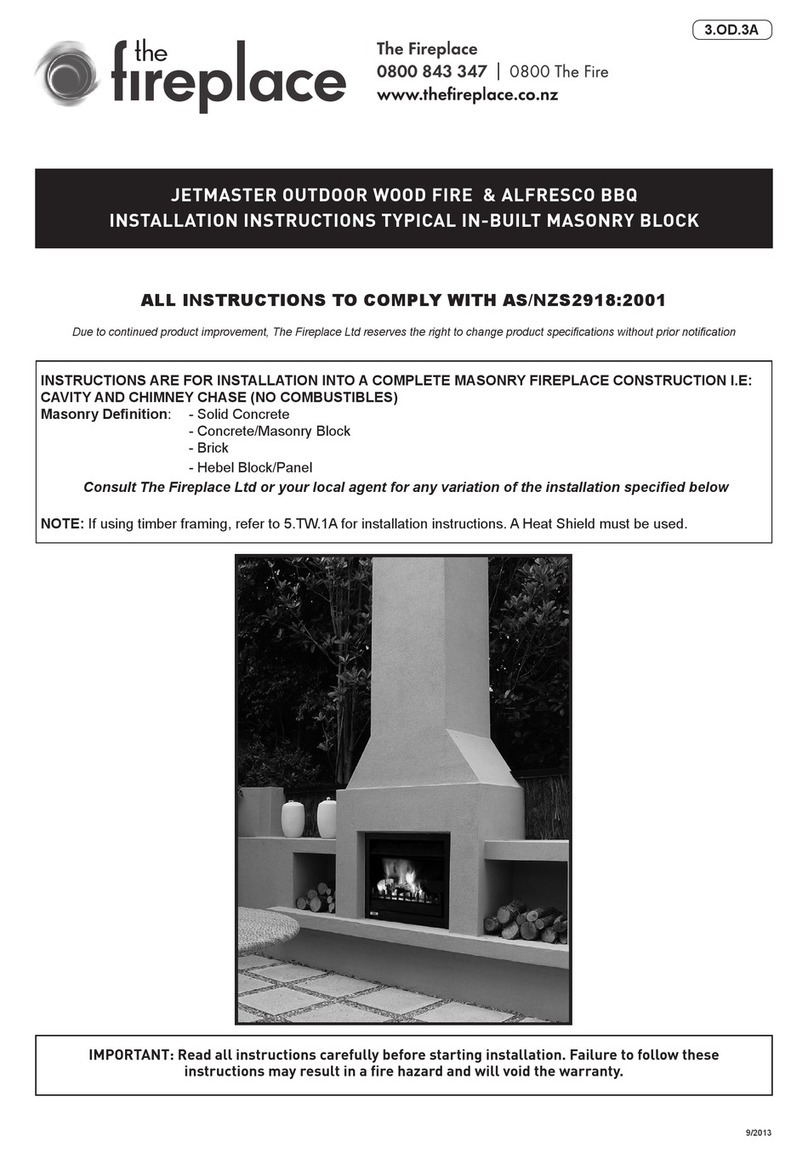
The Fireplace
The Fireplace JETMASTER 700 D installation instructions

Superior
Superior VRE4543EN Installation and operation instructions
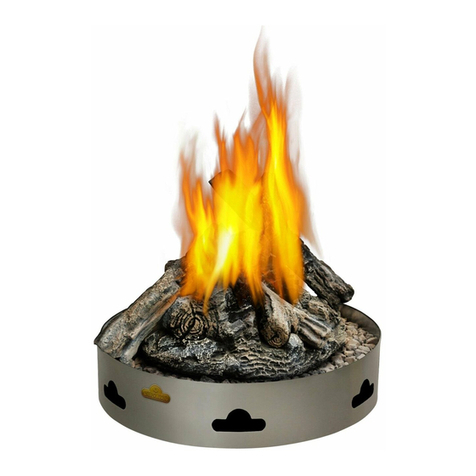
Napoleon
Napoleon PATIOFLAME GPFN Installation and operation instructions

Endless Summer
Endless Summer Dakota GAD19101ES owner's manual

Vermont Castings
Vermont Castings ODGSR36A Homeowner's installation and operating manual

FEUERHAND
FEUERHAND PYRON user manual
